The Ice Lotus, often mistaken for a begonia, is actually a unique variety of lotus (Nelumbo nucifera). This perennial aquatic plant features a horizontally growing, thick, swollen rhizome with numerous longitudinal air ducts and adventitious roots underneath. Its round, shield-shaped leaves, known as peltate leaves, have slightly wavy edges and a smooth top surface dusted with a waxy, water-repellent coating that gives it a white, powdery appearance. The leaves are supported by stout, cylindrical, hollow petioles that allow for gas exchange.
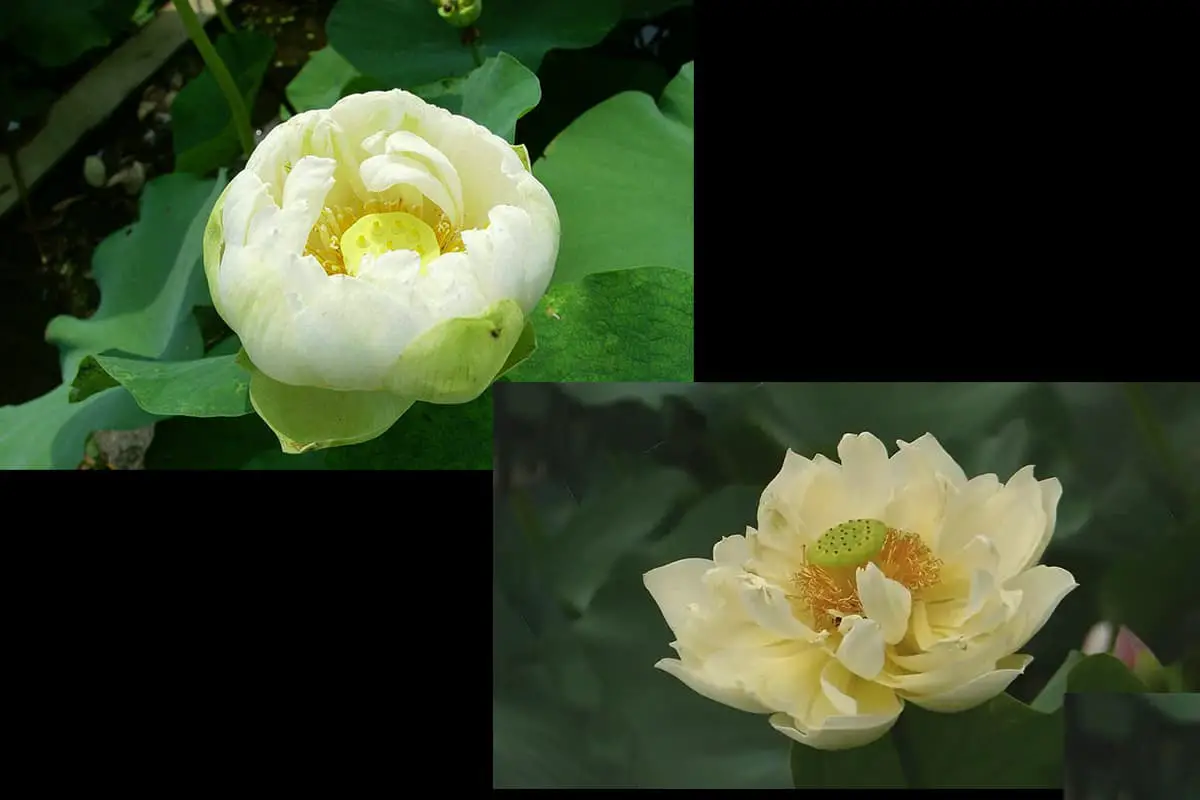
The Ice Lotus produces stunning double flowers consisting of approximately 90 petals, arranged in a bowl-like shape. Before blooming, the flower buds are green and spherical, resembling small peaches. When fully open, the flowers display a unique coloration: predominantly pale yellow or cream, with the inner petals featuring striking green variations. This distinctive color pattern is what gives the Ice Lotus its name and sets it apart from other lotus varieties.
As an aquatic plant, the Ice Lotus thrives in relatively stable, shallow water environments such as lakes, swamps, wetlands, and ponds. It has a strong affinity for sunlight and requires full light exposure during its active growth period. The plant cannot tolerate shade well and will exhibit pronounced phototropism (growth towards light) when grown in semi-shaded conditions.
The Ice Lotus is an artificially cultivated variety, developed through selective breeding for its ornamental qualities. It is widely used in landscape design, particularly in parks, gardens, and courtyards, where its unique appearance and ability to thrive in aquatic settings make it a popular choice for water features and pond plantings.
To cultivate Ice Lotus successfully, maintain water depths between 20-60 cm (8-24 inches) and ensure the water temperature remains above 15°C (59°F) during the growing season. The plant benefits from nutrient-rich soil or specially formulated aquatic plant fertilizers. Regular removal of dead leaves and spent flowers will promote healthy growth and continuous blooming throughout the season.
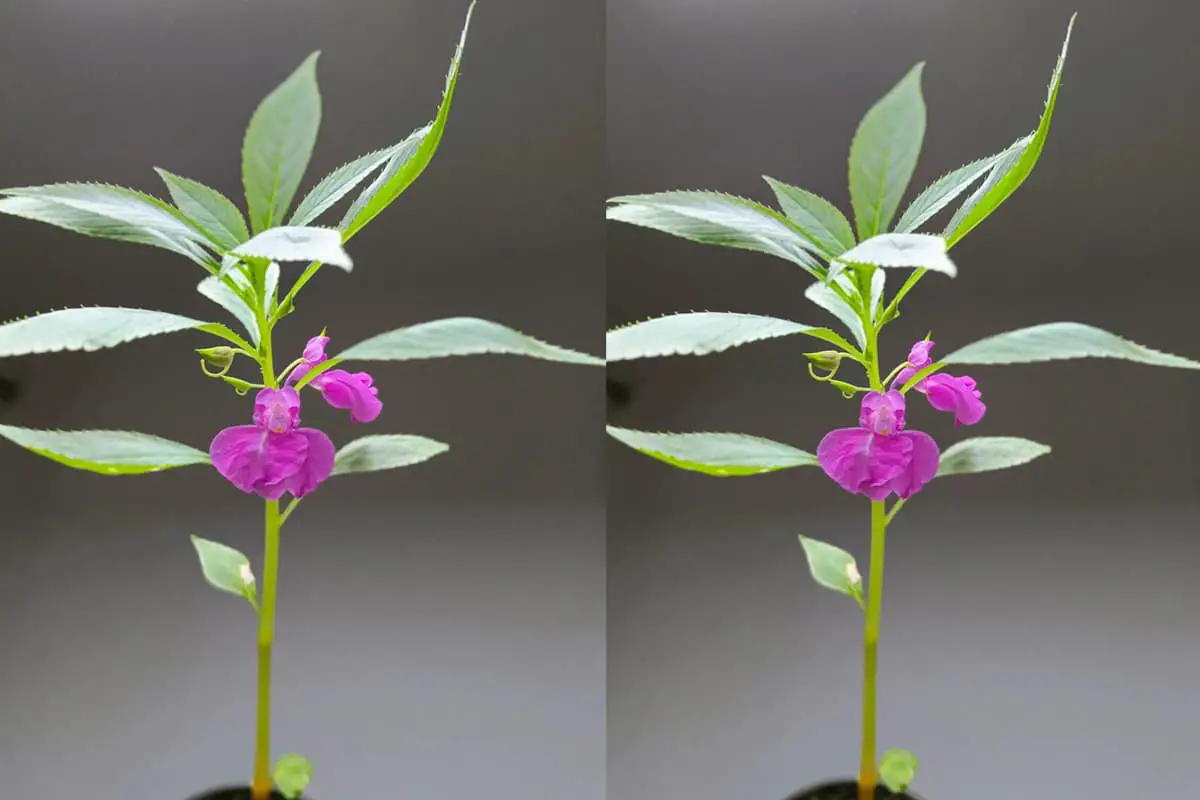
Impatiens Balsamina, commonly known as garden balsam or touch-me-not, is an annual herbaceous plant belonging to the Balsaminaceae family. This vibrant species typically grows to a height of 60-100 cm (24-39 inches). Its stem is sturdy, succulent, and erect, with a distinctive fleshy texture that contributes to its water-storing capacity.
The foliage of Impatiens Balsamina is characterized by its alternate leaf arrangement, although the lowermost leaves may occasionally appear in opposite pairs. The leaf blades exhibit variation in shape, ranging from lanceolate to narrowly elliptical or oblanceolate. These leaves are usually serrated along the margins, adding to the plant’s ornamental appeal.
Flowers of the garden balsam are its most striking feature. They emerge either solitarily or in small clusters of 2-3 from the leaf axils. The blooms showcase a diverse color palette, including white, various shades of pink, and purple. Both single and double flower forms exist, with the double varieties being particularly prized for their full, rose-like appearance. The flowering period extends from July to October, providing a long-lasting display of color in gardens.
The fruit of Impatiens Balsamina is a capsule, broadly fusiform in shape. When mature, these capsules burst open at the slightest touch, explosively dispersing the seeds – a characteristic that gives rise to the plant’s alternative name, “touch-me-not.” The seeds are spherical and dark brown, adapted for efficient dispersal.
Native to the tropical and subtropical regions of Asia, including China, India, and Malaysia, Impatiens Balsamina has a wide distribution. It has naturalized in many parts of the world, including some areas of Europe, temperate Asia, and North America. Interestingly, some of the most valuable species within the genus are found in colder regions, such as the Tibetan Plateau, demonstrating the adaptability of the genus.
In the Chifeng area of Inner Mongolia, China, a particularly esteemed variety known as “Buddha’s Top Bead” is cultivated. This local cultivar is noted for its exceptional ornamental qualities and cultural significance.
Regarding cultivation, Impatiens Balsamina thrives in full sun to partial shade and is known for its heat tolerance. However, it is sensitive to frost, making it unsuitable for year-round outdoor cultivation in colder climates.
The plant prefers well-draining, fertile soil but demonstrates remarkable adaptability, capable of growing in less-than-ideal soil conditions. This hardiness, combined with its rapid growth and prolific blooming, makes it a popular choice for gardens and container plantings.
Beyond its ornamental value, Impatiens Balsamina has various traditional uses. In herbal medicine, it is attributed with properties that expel wind, remove dampness, activate blood circulation, and alleviate pain. The plant is considered to have a cooling nature and a sweet-bitter taste profile.
The flowers of Impatiens Balsamina contain natural pigments, primarily red and brown hues, making them useful as a source of natural dyes. This application has been utilized in various cultures; for instance, in India, the plant has been traditionally used for body painting. A vibrant red dye can be produced by crushing the red petals with alum, which has been used historically to color fingernails and in other cosmetic applications.
In conclusion, Impatiens Balsamina is a versatile and attractive annual that offers both ornamental and practical benefits. Its ease of cultivation, striking flowers, and multiple uses make it a valuable addition to gardens and a subject of interest in horticultural, medicinal, and ethnobotanical studies.
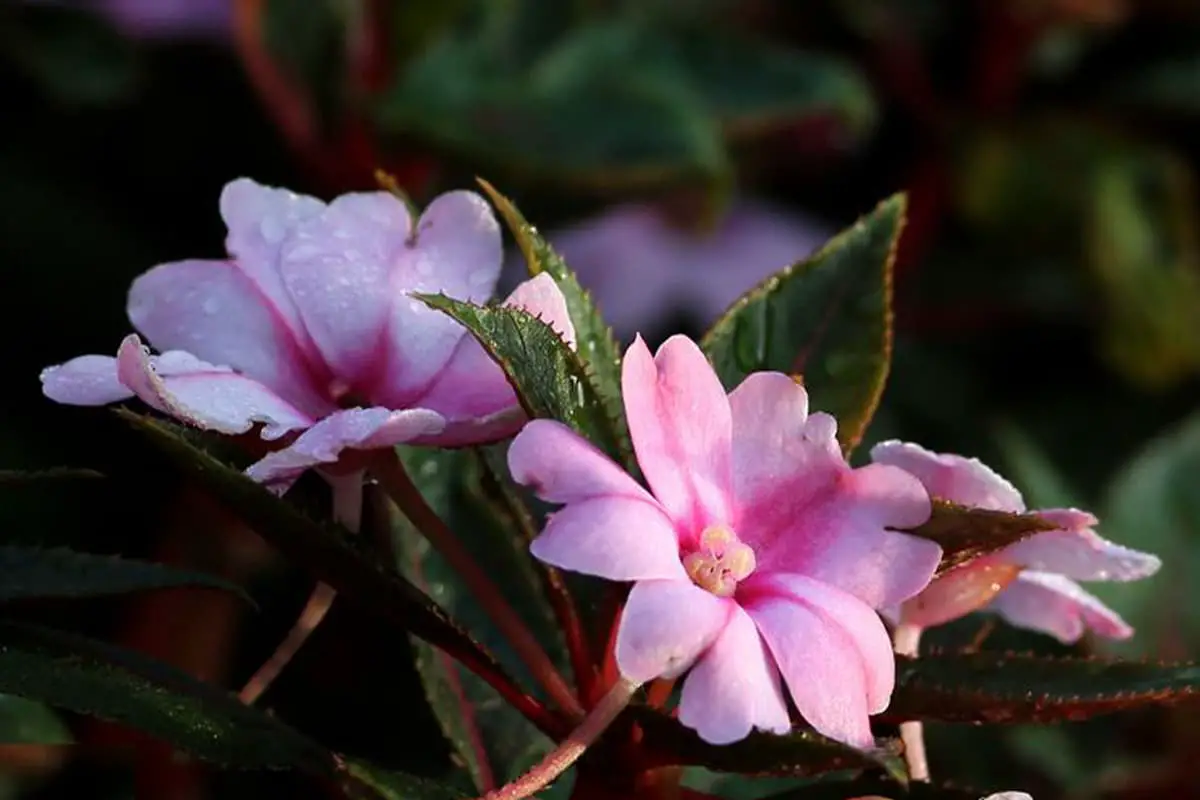
Impatiens hawkeri, commonly known as New Guinea Impatiens, is a striking perennial herbaceous plant belonging to the Balsaminaceae family. This species typically grows to a height of 20-40 cm, forming a compact, bushy habit. The stem is succulent and glabrous, ranging in color from green to reddish-brown, with distinct nodes that are prone to breakage.
The foliage of I. hawkeri is one of its most distinctive features. Leaves are arranged in whorls, usually with 3-5 leaves per node. They are lanceolate to elliptic in shape, 10-25 cm long, with finely serrated margins. The leaf color varies from light yellow-green to deep, lustrous green, often with contrasting veins that may be pink, red, or purple. Interestingly, the coloration of the veins and stems often corresponds to the flower color.
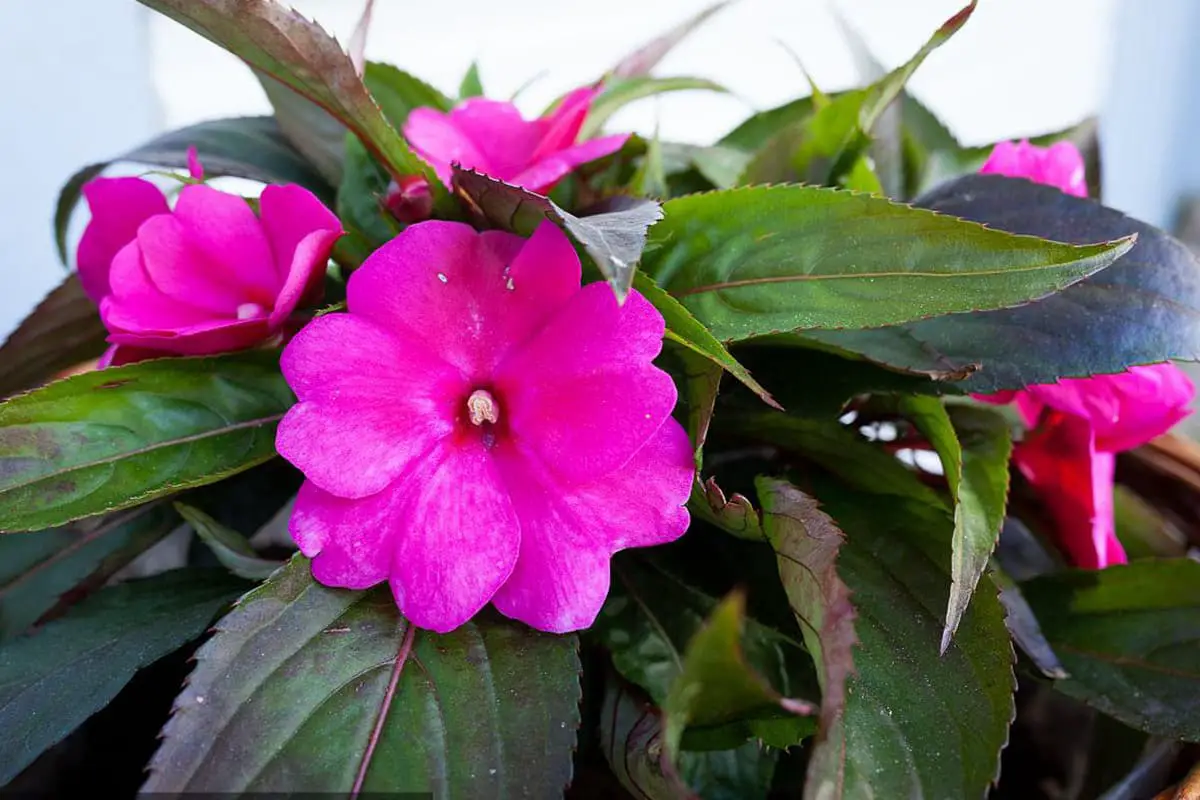
The flowers of New Guinea Impatiens are large and showy, measuring 5-7 cm in diameter. They are borne singly in the leaf axils, with a characteristic spurred structure formed by modified lower petals. The color palette of I. hawkeri is exceptionally diverse, including vibrant shades of magenta, pink, red, orange, salmon, white, and various bicolor combinations. Some cultivars even display patterns such as starbursts or eye zones. The main flowering period extends from late spring through early fall, typically June to September in temperate climates.
Native to the tropical highlands of New Guinea and surrounding islands, I. hawkeri thrives in warm, humid environments with temperatures between 18-27°C (65-80°F). It prefers bright, indirect light and can suffer from leaf scorch in intense, direct sunlight. The plant requires consistently moist, well-draining soil rich in organic matter, with a pH range of 6.0-6.5. Regular feeding with a balanced, water-soluble fertilizer during the growing season promotes vigorous growth and abundant flowering.
Propagation of New Guinea Impatiens is primarily done through stem cuttings, which root easily in water or a moist growing medium. While seed propagation is possible, it is less common due to the prevalence of sterile hybrids in cultivation. Tissue culture is widely used for commercial production, ensuring uniformity and disease-free stock.
In landscaping, I. hawkeri is prized for its vibrant colors, long blooming period, and adaptability to various growing conditions. It excels as a bedding plant in partial shade gardens, creating stunning mass plantings or colorful borders. In containers, it makes an excellent choice for patios, balconies, and indoor spaces with adequate light. The plant’s compact growth habit also makes it suitable for hanging baskets and window boxes.
The floriography, or flower language, associated with New Guinea Impatiens includes “Don’t touch me” – a nod to the genus name Impatiens, which refers to the plant’s tendency to suddenly release its seeds when the ripe capsules are touched. It also symbolizes “Remembering the past,” perhaps due to its enduring popularity in gardens over time.
In conclusion, Impatiens hawkeri is a versatile and visually appealing plant that offers gardeners a wide range of colors and applications. Its care requirements and growth habits make it an excellent choice for both novice and experienced gardeners looking to add vibrant, long-lasting color to their landscapes or indoor spaces.
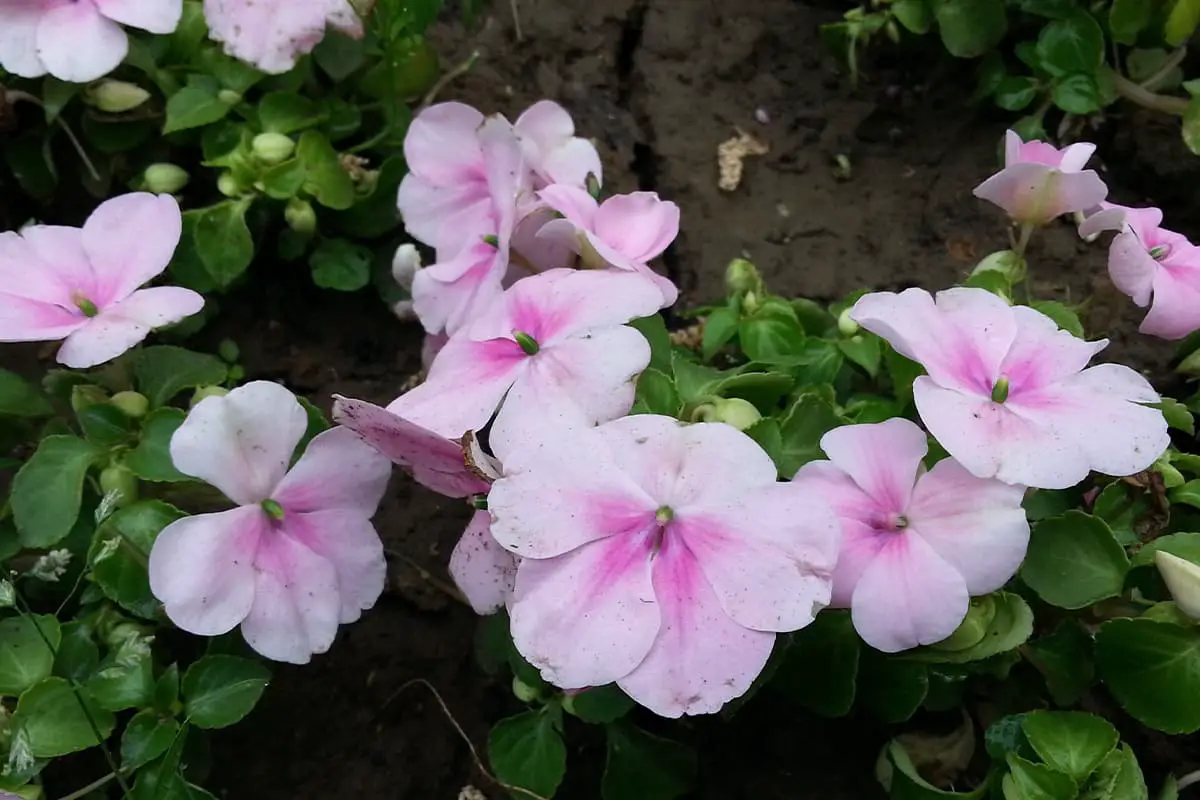
Impatiens walleriana, commonly known as Busy Lizzie or Sultan’s Balsam, is a perennial herbaceous plant belonging to the Balsaminaceae family. This species, native to eastern Africa, has become a popular ornamental plant cultivated worldwide for its vibrant blooms and long flowering period.
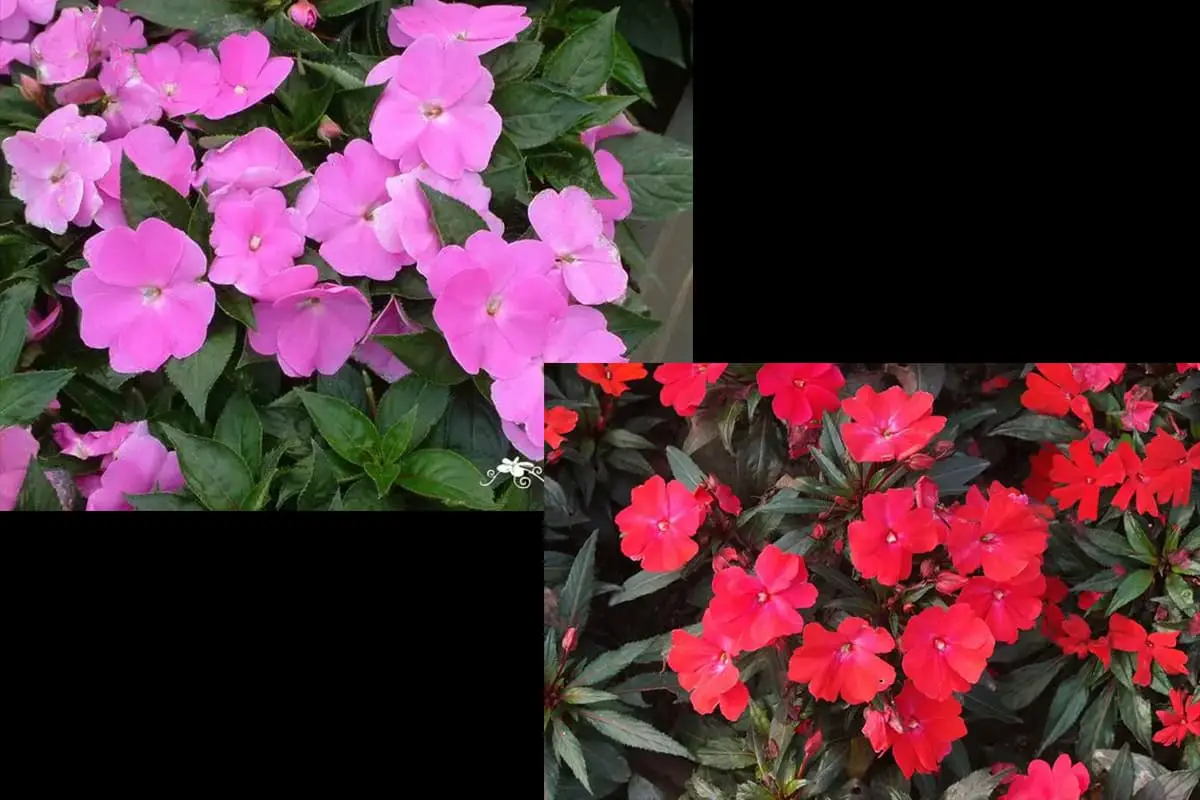
Morphology:
• Height: 30-70 cm (1-2.3 ft)
• Stem: Erect, succulent, green or reddish
• Leaves: Alternate or spirally arranged, particularly at the stem apex
• Leaf shape: Broadly elliptical, ovate, or oblong-elliptical with serrated margins and an acuminate apex
• Leaf color: Dark green, sometimes with a reddish tinge
Flowers:
• Inflorescence: Axillary, typically bearing 1-2 flowers
• Flower size and color: Highly variable, ranging from 2-5 cm in diameter and available in a wide spectrum of colors including white, pink, red, purple, and bicolor varieties
• Flowering period: June to October in temperate climates; year-round in tropical regions
• Fruit: Spindle-shaped capsule, glabrous, explosively dehiscent when mature
Cultural requirements:
• Climate: Prefers warm, humid conditions; not frost-hardy
• Light: Thrives in partial shade to full shade
• Soil: Well-draining, humus-rich soil with consistent moisture
• Watering: Regular watering is essential, but avoid waterlogging
Propagation:
• Seeds: Natural method, self-sows readily
• Stem cuttings: Easy and popular method for vegetative propagation
Horticultural significance:
Impatiens walleriana is prized for its prolific blooming, compact growth habit, and adaptability to various garden settings. It’s particularly valuable for adding color to shaded areas where other flowering plants may struggle. The species has been extensively hybridized, resulting in numerous cultivars with improved characteristics such as heat tolerance, disease resistance, and novel flower forms.
Medicinal uses:
While not commonly used in modern medicine, traditional applications of Impatiens walleriana include:
• Roots, leaves, and seeds: Used in some traditional medicine systems
• Properties: Considered warm in nature, with a sweet and slightly bitter taste
• Preparation: Typically dried before use
• Caution: Medicinal use should only be under professional guidance, as scientific evidence for efficacy and safety is limited
Ecological impact:
In some regions, Impatiens walleriana has naturalized and can become invasive, potentially outcompeting native flora. Gardeners should be aware of local regulations and ecological considerations when planting this species outside its native range.
By combining ornamental appeal with low maintenance requirements, Impatiens walleriana remains a favorite among gardeners for adding reliable color to shaded garden beds, hanging baskets, and container plantings.
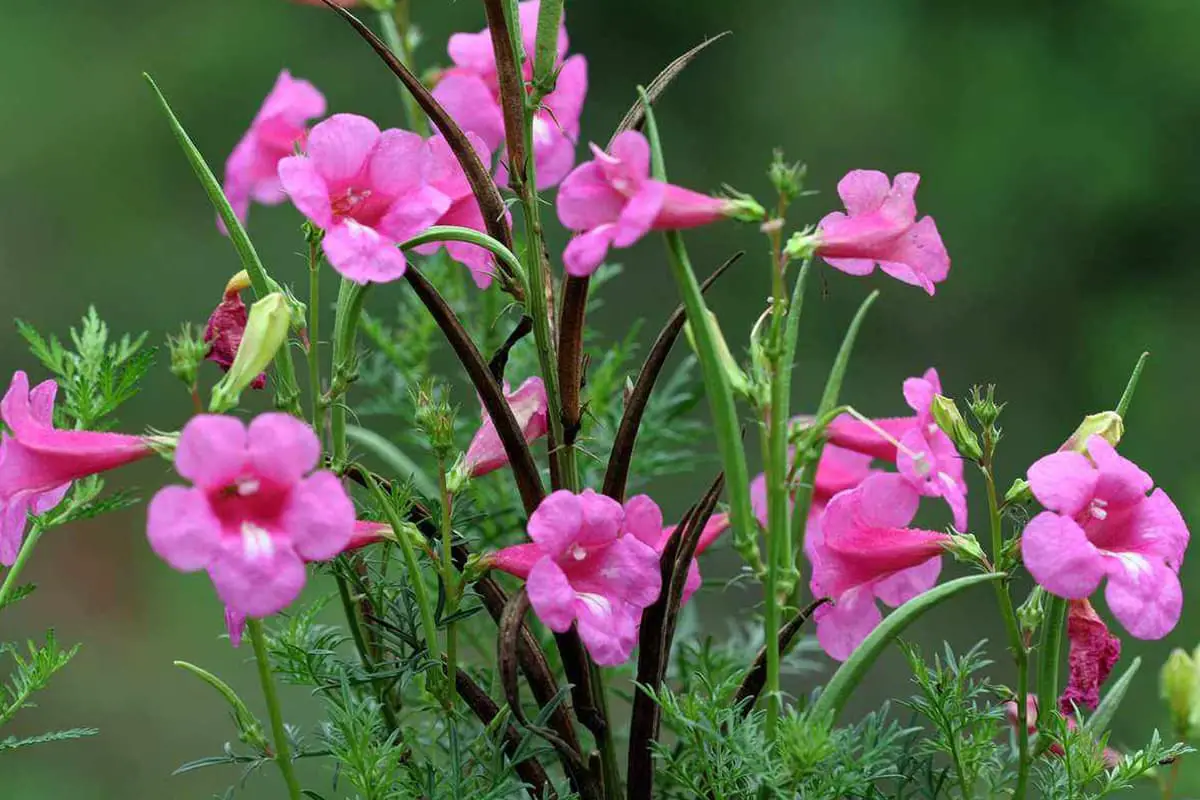
Impatiens walleriana, commonly known as Busy Lizzie or Sultan’s Balsam, is a perennial herbaceous plant belonging to the family Balsaminaceae. This species typically grows to a height of 15-60 cm (6-24 inches). The stem is succulent, erect, and can be green or reddish in color.
The leaves are arranged alternately or spirally, particularly towards the apex of the stem. The leaf blade is broadly elliptical, ovate, or oblong-elliptical in shape, with serrated margins and an acuminate tip. Leaves are usually 3-12 cm long and 2-5 cm wide.
Flowers are axillary, generally appearing in pairs, though sometimes solitary. They exhibit remarkable diversity in size and color, ranging from white, pink, red, purple, to bi-colored varieties. Each flower has five petals, with one modified into a distinctive spurred pouch. The bloom size typically ranges from 2-5 cm in diameter.
The fruit is a capsule, fusiform in shape and glabrous (hairless). When mature, it explosively dehisces, scattering seeds considerable distances – a characteristic trait of the genus Impatiens.
Impatiens walleriana flowers prolifically from late spring through autumn (May to October in the Northern Hemisphere), making it a popular choice for continuous color in gardens.
Native to eastern Africa, particularly Tanzania and Mozambique, this species has been widely cultivated globally as an ornamental plant. It thrives in warm, humid environments and is not frost-hardy. Impatiens walleriana prefers partial shade, though it can tolerate full sun in cooler climates if provided with adequate moisture. The ideal growing medium is a well-draining, humus-rich soil with consistent moisture.
Propagation is primarily through seeds, which germinate readily. Vegetative propagation via stem cuttings is also highly successful and often employed in commercial production.
The compact growth habit, profuse blooming, and wide color palette make Impatiens walleriana an excellent choice for bedding plants, hanging baskets, and container gardens. They are particularly valued for bringing color to shaded areas where many other flowering plants struggle.
While some Impatiens species have documented medicinal uses, it’s important to note that Impatiens walleriana is primarily cultivated for ornamental purposes. Any medicinal applications should be approached with caution and under professional guidance, as the plant may contain compounds that could be harmful if misused.
In recent years, Impatiens walleriana has faced challenges from downy mildew (Plasmopara obducens), leading to the development of resistant cultivars and increased interest in alternative Impatiens species for garden use.
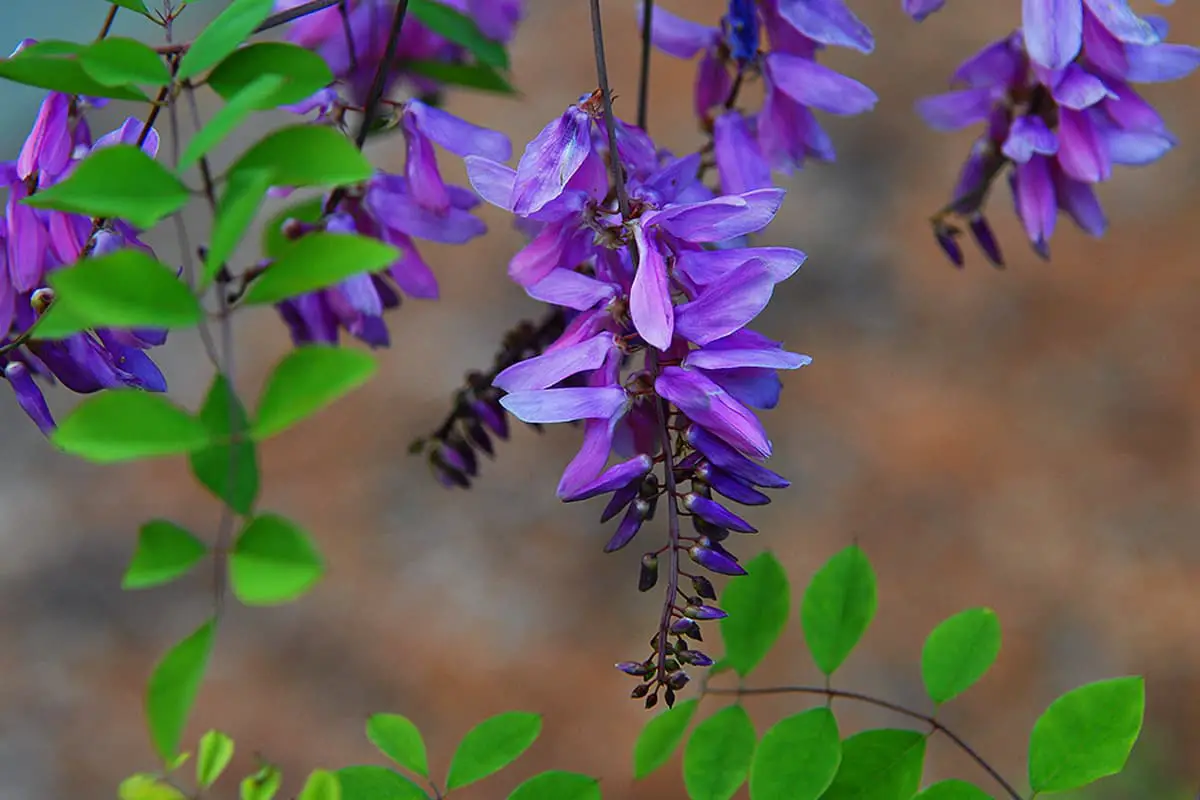
Indigofera kirilowii, commonly known as Kirilow’s Indigo or Chinese Indigo, is a small deciduous shrub belonging to the Fabaceae family. This species typically grows to a height of 0.3 to 1 meter, with a spreading habit. Its stems are cylindrical, and young branches often display distinctive ridges or angles.
The plant is characterized by its sparse covering of white, T-shaped (cruciform) trichomes, which are present on the leaf rachis, both leaf surfaces, and inflorescences. This pubescence gives the plant a slightly silvery appearance, especially on new growth.
Leaves of I. kirilowii are pinnately compound and alternate, not opposite as previously stated. Each leaf consists of 7-15 leaflets, which are broadly ovate, rhomboid-ovate, or elliptical in shape. Leaflets measure 1-3 cm long and 0.5-2 cm wide, with rounded or acute apices and cuneate to broadly cuneate bases. The undersides of the leaflets are a lighter, almost glaucous green, with prominent lateral veins.
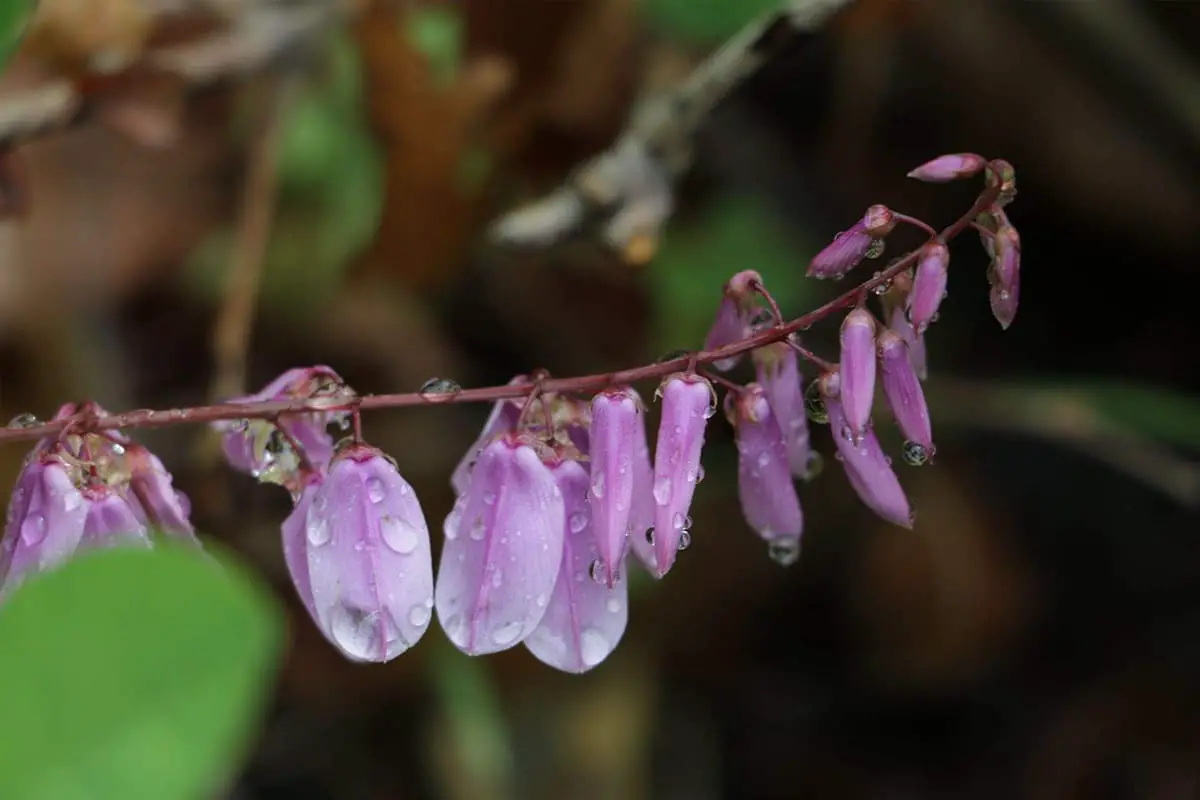
The inflorescence is an axillary raceme, typically 5-15 cm long, bearing 10-30 flowers. The calyx is cup-shaped with five triangular-lanceolate teeth. Flowers are papilionaceous, measuring 8-12 mm long, and are predominantly pale pink to rose-colored, though white forms occasionally occur. The standard petal is broadly elliptical and reflexed.
Fruits are linear, cylindrical legumes, 2-4 cm long and 3-4 mm wide, containing 6-10 seeds. Seeds are reddish-brown, oblong, and approximately 2 mm in length. Flowering occurs from late spring to early summer (May to July), with fruits maturing in late summer to early autumn (August to September).
Indigofera kirilowii is native to East Asia, with a distribution encompassing various provinces in China (including Hebei, Henan, Liaoning, Shandong, and Shanxi), as well as parts of Korea and Japan. It thrives in diverse habitats, including shrublands, sparse forests, hillsides, and rocky crevices, typically at elevations between 100-1500 meters above sea level.
This species demonstrates considerable adaptability, tolerating a range of soil conditions including poor and dry soils. It performs best in full sun to partial shade and is notably drought-resistant once established. Propagation can be achieved through seeds, stem cuttings, root division, and layering.
In traditional Chinese medicine, Indigofera kirilowii has been utilized for its purported medicinal properties. The plant is considered to have a bitter taste and cooling properties. It is believed to possess anti-inflammatory, analgesic, antipyretic, detoxifying, and mild laxative effects. Traditional uses include treatments for throat inflammation, bronchitis, fever-induced constipation, hemorrhoids, and jaundice. However, it’s important to note that these medicinal applications should be approached with caution and under professional guidance, as scientific validation for many traditional uses is limited.
Beyond its medicinal applications, I. kirilowii has various practical uses. The stem bark fibers can be processed into a cotton-like material or used in the production of fiberboard and paper. Its flexible branches are suitable for basket weaving. The seeds contain oils and starches that have potential industrial applications, while the leaves are a source of tannins used in leather tanning.
In horticulture, Indigofera kirilowii is valued for its ornamental qualities. Its abundant, fragrant flowers and dense foliage make it an attractive choice for gardens and landscapes. The plant serves as an excellent nectar source for pollinators, contributing to local biodiversity. Its compact size and adaptability make it suitable for borders, rock gardens, and mixed shrub plantings.
In the language of flowers, Indigofera kirilowii is associated with qualities such as loveliness, warmth, delicacy, youth, and brightness, reflecting its charming appearance and the positive associations it has garnered in cultural contexts.
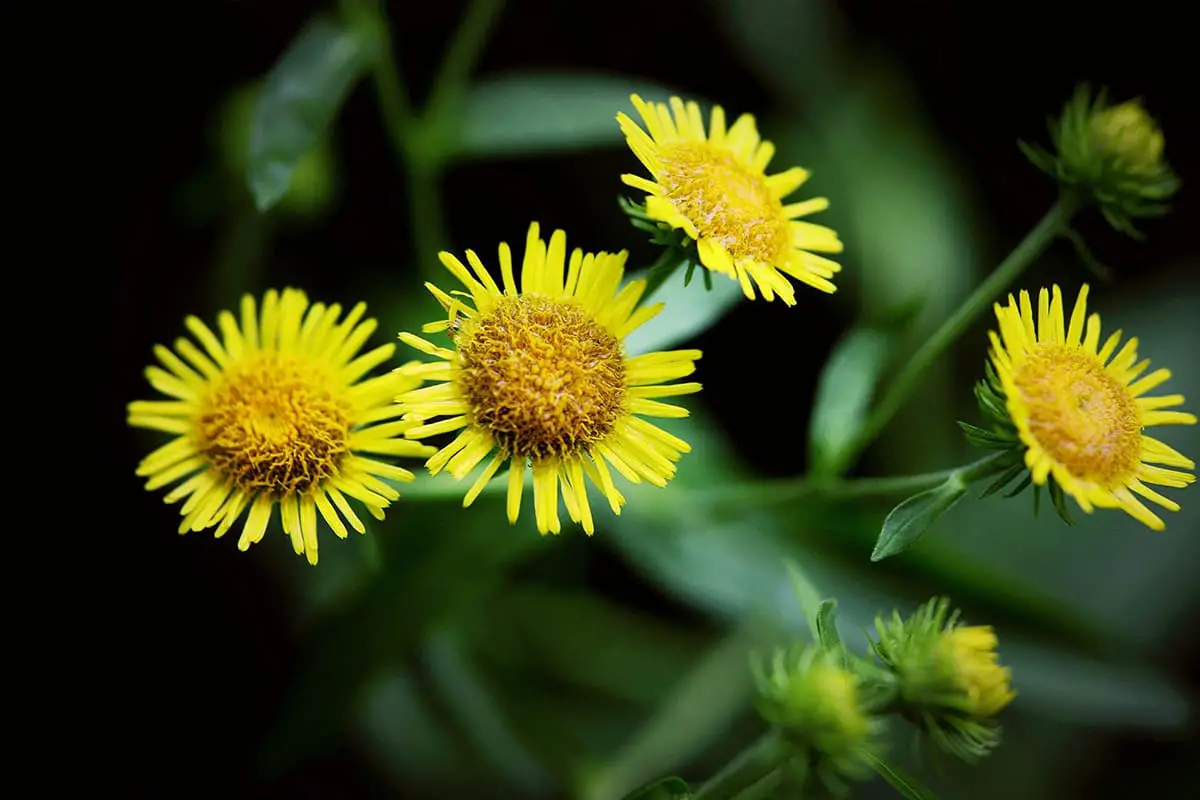
Inula japonica, commonly known as the Japanese Inula or Japanese Elecampane, is a perennial herbaceous plant belonging to the Asteraceae family. This species is characterized by its distinctive morphology and wide distribution across East Asia.
The plant typically grows to a height of 30-100 cm. Its stem is erect and branched, covered with long, soft hairs (hirsute), particularly in the upper portions, while the lower parts may be glabrous (smooth). The leaves exhibit a notable variation in shape and arrangement along the stem. The middle leaves are oblong, lanceolate, or oblanceolate, measuring 5-15 cm long and 1-4 cm wide. These leaves are sessile, often featuring rounded, semi-amplexicaul (partially stem-clasping) auricles at the base, which is a key identifying characteristic.
As the stem ascends, the upper leaves transition to a linear-lanceolate shape, becoming progressively smaller. The leaf margins are typically serrate or dentate, and both surfaces may be pubescent or glabrescent.
The inflorescence of Inula japonica is a loosely arranged umbellate corymb, comprising multiple flower heads (capitula). Each capitulum is supported by a long, slender peduncle. The flowers are radiate, with bright yellow ligulate (ray) florets surrounding tubular disk florets, creating a daisy-like appearance. The involucre is hemispherical, with linear-lanceolate bracts arranged in 3-4 series.
Flowering occurs from June to October, depending on the geographical location and local climate conditions. Following pollination, the plant produces cylindrical achenes (dry, single-seeded fruits) that are sparsely covered with short hairs. The pappus, which aids in wind dispersal, consists of numerous barbellate bristles. Fruit maturation and dispersal typically take place from September to November.
Inula japonica demonstrates a wide geographic distribution, with its native range spanning several provinces in China, including Anhui, Fujian, Gansu, Guangdong, Guizhou, Hebei, Heilongjiang, Henan, Hubei, Hunan, Jiangsu, Jiangxi, Liaoning, Shaanxi, Shandong, Shanxi, Sichuan, Yunnan, and Zhejiang. Beyond China, it is also found in Mongolia, the Korean Peninsula, parts of Siberia in Russia, and throughout Japan.
This species thrives in warm, humid climates and demonstrates a preference for specific soil conditions. Optimal growth is achieved in deep, loose, and fertile sandy loam soils that are rich in organic matter. Good drainage is essential for healthy development. Inula japonica is often found growing naturally in moist grasslands, along stream banks, and in the understory of open woodlands.
Propagation of Inula japonica is primarily achieved through two methods:
In traditional East Asian medicine, particularly in Chinese herbal practices, the dried capitulum (flower head) of Inula japonica, known as “Xuan Fu Hua” (旋覆花), has been utilized for centuries. The medicinal properties are attributed to its bitter and pungent taste, coupled with a slightly warm nature according to traditional Chinese medicine principles. Its reported therapeutic actions include:
These properties make it a valuable herb in treating various respiratory and digestive ailments. However, it’s important to note that the use of any herbal remedy should be under the guidance of a qualified practitioner, as improper use can lead to adverse effects.
In addition to its medicinal applications, Inula japonica has potential ornamental value in garden settings, particularly in naturalized areas or wildflower meadows, where its bright yellow flowers can provide late-season color and attract pollinators.
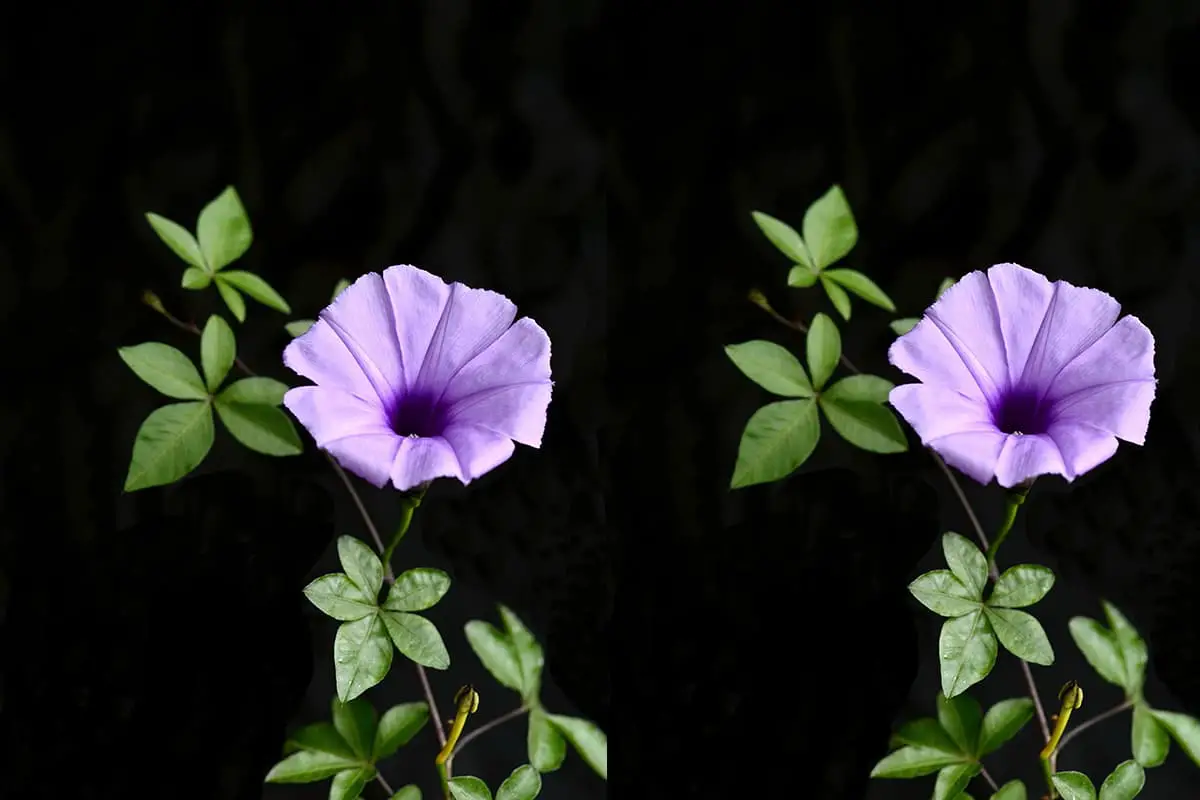
Ipomoea cairica, commonly known as the Five-fingered Morning Glory or Railway Creeper, is a vigorous perennial vine belonging to the Convolvulaceae family. This ornamental plant is characterized by its slender, twining stems and distinctive palmate leaves, typically divided into five to seven deep lobes, giving rise to its common name.
The flowers of Ipomoea cairica are striking and funnel-shaped, measuring 3-5 cm in diameter. While the most common color is a vibrant lavender-purple, variations in pink, red, and occasionally white can be observed. These blooms open in the morning and usually close by afternoon, following the characteristic pattern of morning glories. The flowering period generally extends from late spring through autumn, typically May to December, depending on the climate.
Following pollination, the plant produces nearly spherical capsules as fruit, containing 4-6 seeds. It’s worth noting that Ipomoea cairica is a self-incompatible species, meaning it cannot self-pollinate. This characteristic necessitates cross-pollination, typically facilitated by insects, for successful seed production. However, the plant also readily propagates vegetatively through its stems and runners, contributing to its rapid spread in favorable conditions.
Native to tropical and subtropical regions of Africa and Asia, the Five-fingered Morning Glory has adapted to thrive in warm, humid, and sunny environments. It demonstrates remarkable heat and drought tolerance, making it suitable for a wide range of growing conditions. However, it is not frost-hardy and may suffer damage or die back in freezing temperatures.
In its natural habitat, Ipomoea cairica is often found scrambling over other vegetation in mountain valley forests, climbing through hillside shrubs, and even colonizing rock crevices. Its robust climbing ability, achieved through twining stems, allows it to rapidly cover large areas, sometimes reaching heights of up to 10 meters when supported.
The ornamental value of Ipomoea cairica is significant, stemming from both its attractive foliage and showy flowers. As a versatile climbing plant, it is extensively used in vertical gardening applications. It excels in various landscape settings, including:
While Ipomoea cairica offers numerous benefits in controlled settings, it’s important to note its potential for invasiveness in some regions. Its rapid growth and efficient propagation methods can lead to it outcompeting native vegetation if left unchecked. Therefore, responsible cultivation and management practices are crucial, especially in areas where it is not native.
In conclusion, the Five-fingered Morning Glory is a versatile and attractive vine that, when properly managed, can provide stunning visual interest and practical benefits in a wide range of landscaping applications. Its unique foliage, beautiful flowers, and adaptable nature make it a valuable addition to many garden designs, particularly in warm climates where its vigorous growth can be fully appreciated.
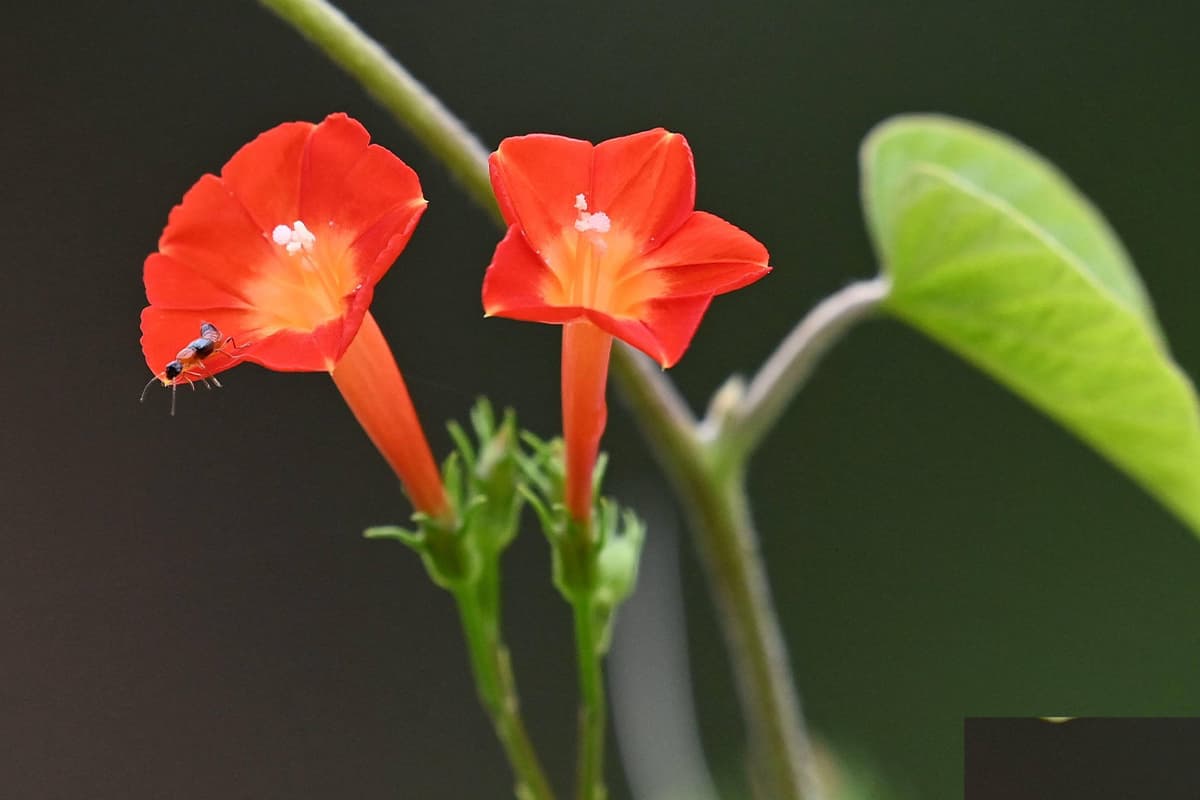
The Ipomoea cholulensis, commonly known as the Orange Morning Glory or Round Leaf Morning Glory, is an annual climbing vine belonging to the Convolvulaceae family. This striking plant features smooth, twining stems and characteristically heart-shaped leaves that may exhibit deep lobing in some varieties.
Flowering occurs from late June through August, showcasing vibrant orange blooms with distinctive yellow throats. The flowers possess a long, slender tube that dramatically widens at the throat, creating an eye-catching trumpet shape. Following the flowering period, the plant produces small, spherical fruits containing ovate or round seeds.
Native to South America, Ipomoea cholulensis thrives in well-draining, slightly moist soil conditions. While it demonstrates some drought tolerance, consistent moisture is preferred for optimal growth. This species is heliotropic, requiring full sun exposure for abundant flowering and vigorous growth. It is important to note that the plant is intolerant of both shade and frost.
As an annual, the Orange Morning Glory completes its life cycle within one growing season. As autumn approaches and temperatures drop, the foliage begins to yellow, signaling the end of its growth period. The plant will naturally die off with the onset of colder weather.
Propagation of Ipomoea cholulensis is primarily achieved through seed sowing. In most temperate climates, seeds are typically planted in April to align with the warming spring temperatures. To enhance germination, it is recommended to scarify the hard seed coat or soak the seeds in warm water for 24 hours before planting.
The Orange Morning Glory’s rapid growth and climbing habit make it an excellent choice for various ornamental applications. It is particularly well-suited for ground planting in gardens, where it can quickly cover fences, trellises, or arbors. Its versatility extends to container gardening, making it an attractive option for adorning windows and balconies with cascading foliage and brilliant blooms.
As a vertical greening solution, Ipomoea cholulensis offers several benefits. Its fast-growing nature provides quick coverage, creating privacy screens or disguising unsightly structures. The dense foliage and prolific flowers not only enhance aesthetic appeal but also contribute to urban biodiversity by attracting pollinators such as bees and butterflies.
When cultivating Orange Morning Glory, it’s essential to provide sturdy support structures to accommodate its vigorous growth. Regular pruning may be necessary to manage its spread and maintain the desired shape. While generally low-maintenance, monitoring for common pests like aphids and spider mites is advisable to ensure the plant’s health and vitality throughout the growing season.
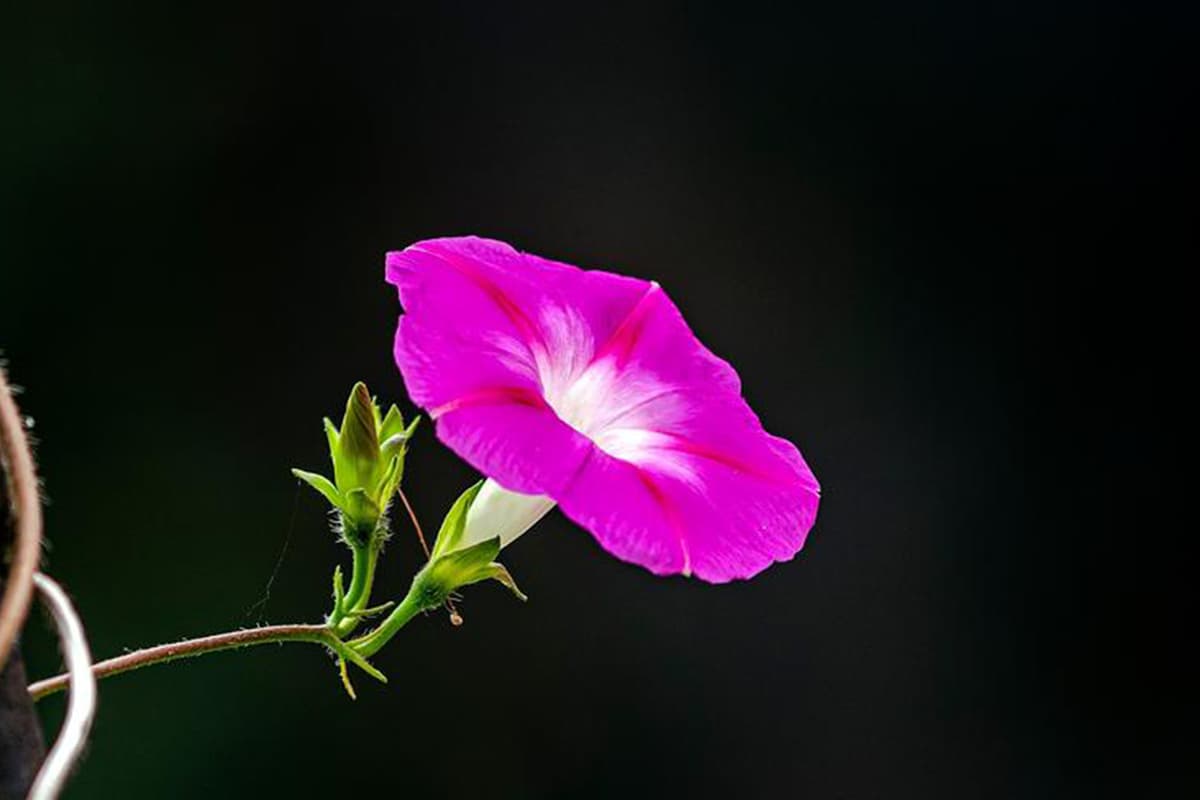
Ipomoea nil, commonly known as Japanese morning glory or blue morning glory, is an annual climbing vine belonging to the Convolvulaceae family. This species is characterized by its rapid growth and prolific flowering, making it a popular ornamental plant in gardens worldwide.
Morphology:
The plant features twining stems that can reach lengths of up to 5 meters (16 feet). Its leaves are broadly ovate to cordate, 5-15 cm long, with a pointed apex and a heart-shaped base. The foliage is deep green and may be slightly pubescent.
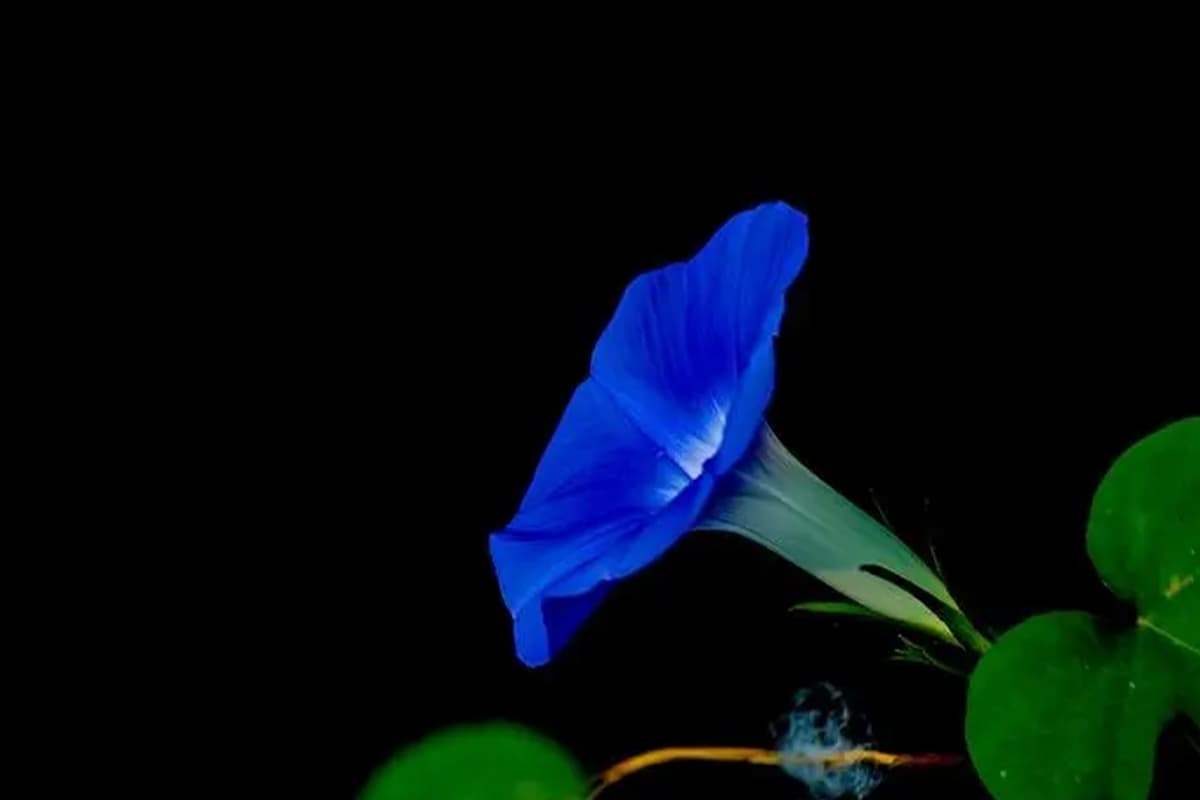
Flowers:
The most striking feature of Ipomoea nil is its large, trumpet-shaped flowers. These blooms are typically 5-8 cm in diameter and appear in various shades of blue, violet, or purplish-red. Unlike some other morning glory species, the corolla of I. nil is glabrous (hairless). Flowers open in the early morning and close by midday, hence the common name “morning glory.” The flowering period extends from early summer (June) through early autumn (September).
Fruit and Seeds:
Following pollination, nearly spherical capsules develop, containing 4-6 seeds each. The seeds are egg-shaped, trihedral, and measure about 5 mm in length. They vary in color from black-brown to milky yellow and are covered with short, velvety brown hairs. The fruiting period occurs from September to October.
Origin and Distribution:
Native to tropical America, Ipomoea nil has been widely cultivated and naturalized across tropical and subtropical regions globally. In China, it is found throughout most of the country, excluding some northwestern and northeastern areas where the climate is less suitable.
Growing Conditions:
Ipomoea nil thrives in full sun and prefers well-draining, moderately fertile soil. It requires consistent moisture but can tolerate short periods of drought once established. While it favors warm temperatures, this species can withstand some degree of coolness, making it adaptable to various climates. However, it is not frost-hardy and will die back in freezing conditions.
Propagation:
The primary method of propagation is through seeds. For best results, seeds should be scarified (nicked or abraded) and soaked in water for 24 hours before planting to improve germination rates. Sow seeds directly in the garden after the last frost date or start indoors 4-6 weeks before the expected last frost.
Medicinal Properties:
In traditional medicine, Ipomoea nil has been used for various purposes, though it should be noted that the plant contains toxic compounds and should not be consumed without professional guidance. Its reported medicinal properties include:
These properties have led to its use in treating conditions such as edema, respiratory congestion, and parasitic infections. However, scientific research on its efficacy and safety is limited, and professional medical advice should always be sought before using any plant for medicinal purposes.
Landscaping Uses:
Ipomoea nil is a versatile ornamental plant with several applications in garden design:
Cultivation Tips:
By incorporating Ipomoea nil into gardens or landscapes, one can enjoy its beautiful flowers, rapid growth, and versatile nature while being mindful of its potential invasiveness in some regions.
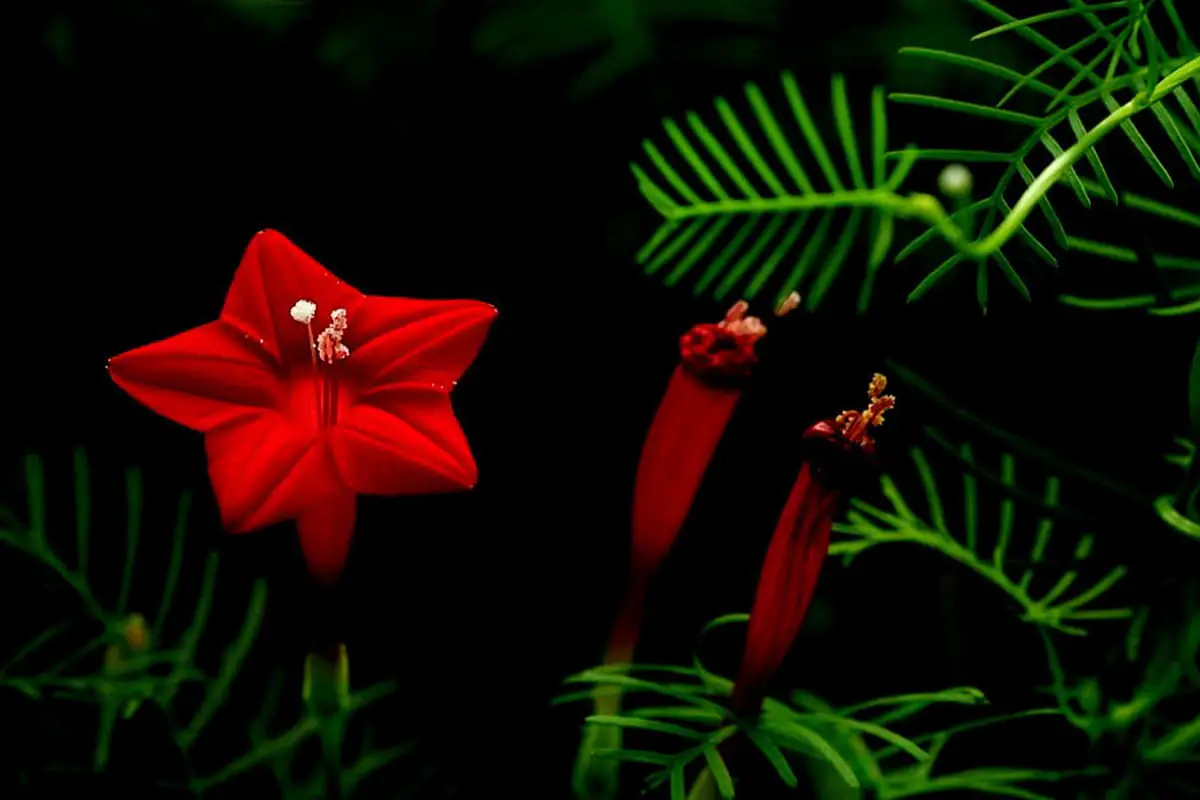
Ipomoea quamoclit, commonly known as cypress vine or cardinal climber, is a species of flowering plant in the morning glory family (Convolvulaceae). This annual, tender, twining herbaceous vine is prized for its delicate, fern-like foliage and vibrant, trumpet-shaped flowers.
The leaves of I. quamoclit are distinctive, being deeply pinnately lobed almost to the midrib, creating a feathery appearance reminiscent of cypress foliage. Each leaf is 2-4 inches long, with numerous narrow, linear segments. The foliage is a rich green color, providing an attractive backdrop for the flowers.
The inflorescence is axillary, typically producing 1-3 flowers in a cyme. The flowers are borne on slender pedicels that are longer than the sepals and become thickened and club-shaped as the fruit develops.
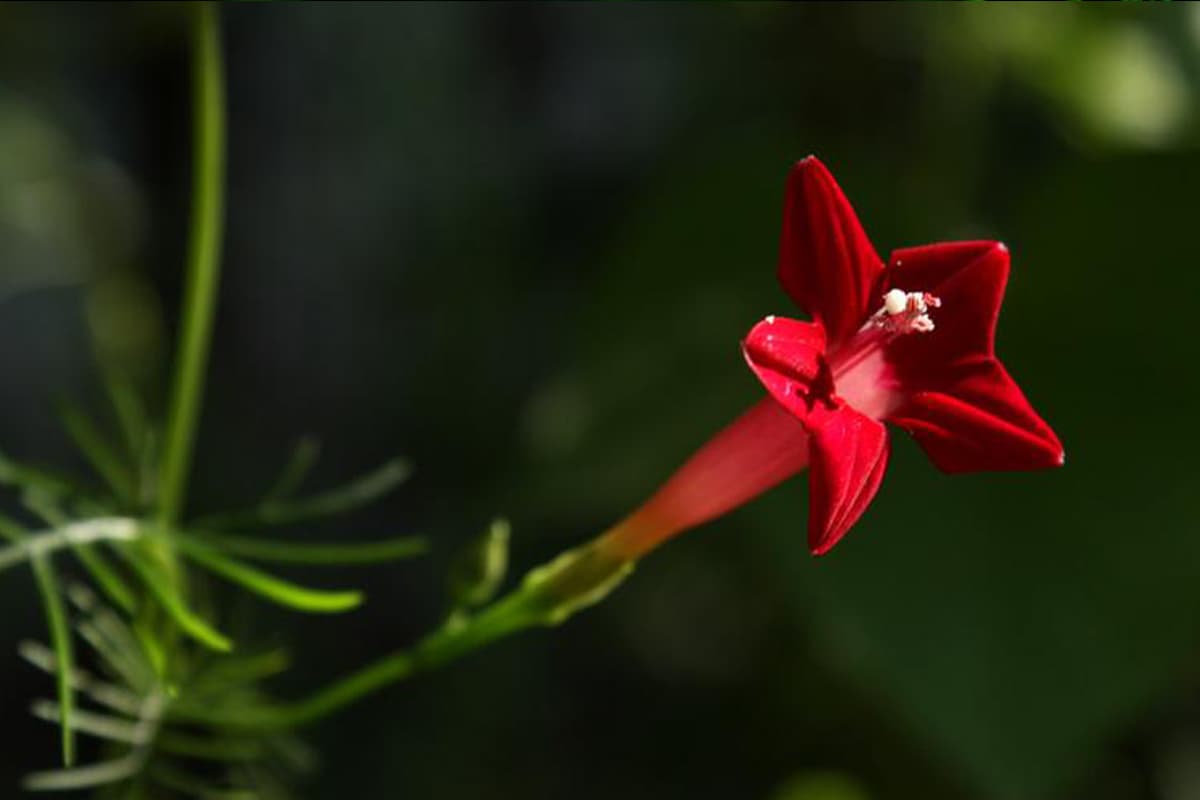
The calyx consists of five sepals that are green, ovate to oblong-spatulate, and about 5-6 mm long. They are obtuse at the apex with a small mucro (pointed tip). The corolla is salverform (having a long, slender tube that abruptly expands into a flat, spreading limb), measuring 2-3 cm long. While the most common color is a striking scarlet red, cultivars with white or pink flowers also exist. The corolla is glabrous (hairless) both inside and out.
After flowering, ovoid capsules about 6-8 mm in diameter develop. These capsules split open when mature to release 2-4 seeds per locule. The seeds are oval-oblong, about 5 mm long, and dark brown to black.
I. quamoclit flowers from mid-summer to early fall, typically July to September in temperate regions. Fruit ripens from September to October.
Native to tropical and subtropical regions of the Americas, I. quamoclit has been widely cultivated and naturalized in many parts of the world. It thrives in USDA hardiness zones 9-11 but is often grown as an annual in cooler climates.
This species prefers full sun exposure and well-draining, moderately fertile soil. While it is somewhat drought-tolerant once established, regular watering promotes lush growth and abundant flowering. I. quamoclit is adaptable to various soil types but performs best in sandy loam with good organic content.
Propagation is primarily by seed. Seeds can be sown directly in the garden after the last frost or started indoors 4-6 weeks before the last expected frost date. To improve germination, it’s recommended to nick or soak the seeds before planting.
In traditional medicine, various parts of I. quamoclit have been used for their purported medicinal properties. The plant is said to have antipyretic (fever-reducing), anti-inflammatory, and laxative effects. It has been used in some cultures to treat conditions such as fever, dysentery, and rheumatism. However, it’s important to note that scientific studies validating these traditional uses are limited, and the plant should not be used medicinally without professional guidance.
As with many members of the Convolvulaceae family, I. quamoclit contains compounds that can be toxic if ingested in large quantities. Care should be taken to keep the plant out of reach of children and pets.
In garden settings, I. quamoclit is primarily grown as an ornamental for its attractive foliage and flowers. It’s an excellent choice for trellises, arbors, or fences, where its fast-growing vines can quickly provide vertical interest and color. The delicate flowers are also attractive to hummingbirds and butterflies, making it a valuable addition to pollinator gardens.
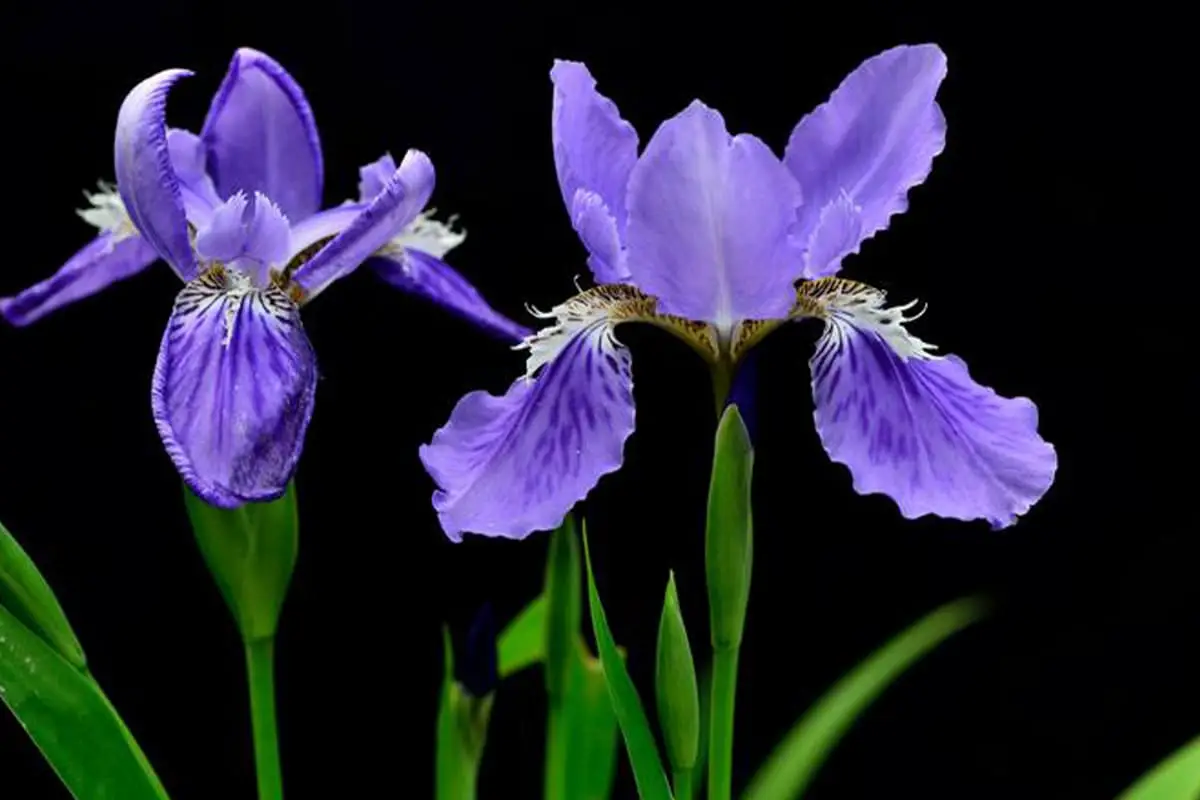
Iris germanica, commonly known as the German Iris or Bearded Iris, is a striking perennial plant belonging to the Iridaceae family. This species is characterized by its robust rhizome, which is flattened and circular with distinctive ring markings. The leaves are sword-shaped, ranging from green to greyish-green, with a powdery bloom and lacking a prominent midrib.
The flower buds of I. germanica are enclosed in green, grassy spathes with membranous edges, occasionally tinged with a subtle red-purple hue. These buds develop into magnificent blooms that showcase the iris’s trademark three upright petals (standards) and three drooping petals (falls), often adorned with intricate patterns and a beard-like structure on the falls. The flowers exhibit a wide range of colors, including purple, blue, yellow, white, and various bicolor combinations.
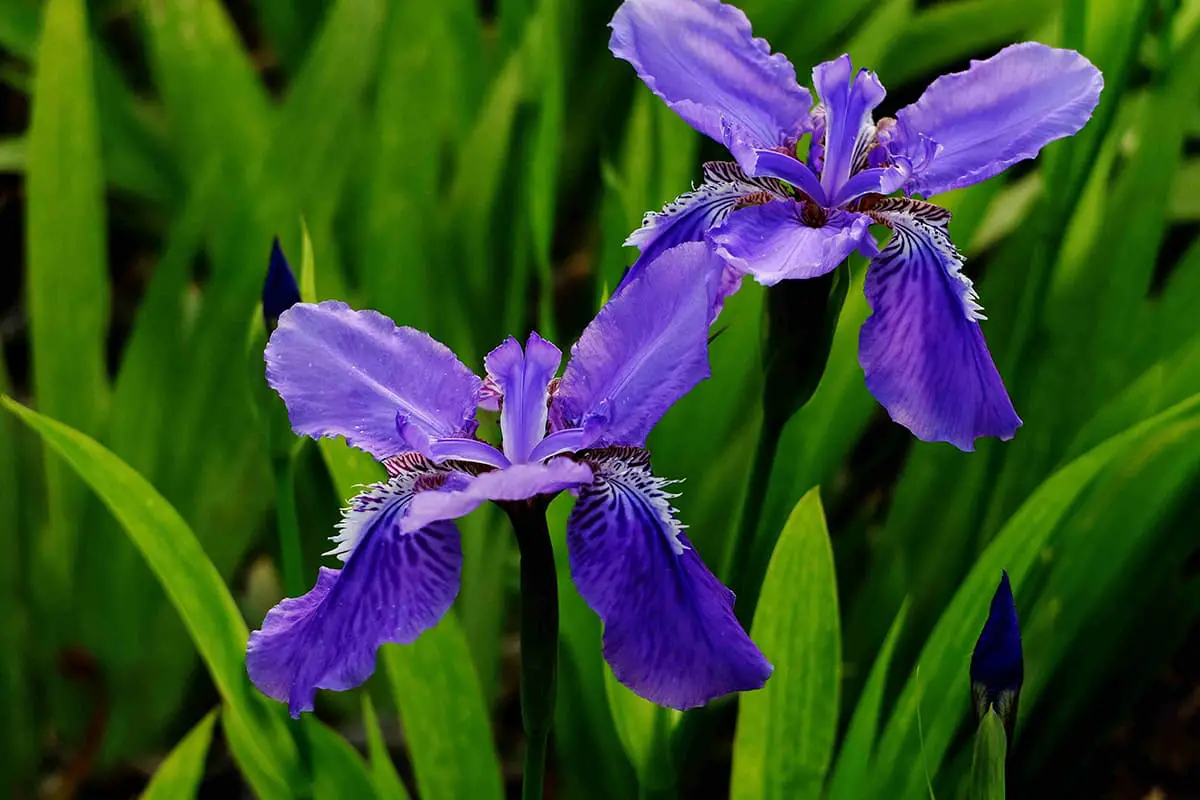
Following the flowering period, which typically occurs from late April to early June depending on the climate, the plant produces trihedral cylindrical capsules as fruit. These capsules contain pear-shaped seeds, each featuring a distinctive yellowish-white appendage at the top. The fruiting period generally extends from June through August.
Native to Central and Southern Europe, I. germanica has been widely cultivated throughout China and many other parts of the world. This species thrives in full sun to partial shade and prefers well-drained, slightly alkaline soils. It demonstrates remarkable cold hardiness, making it suitable for cultivation in USDA zones 3-10. While tolerant of some shade, it is not recommended as a ground cover in densely forested areas due to its preference for ample sunlight.
Propagation of German Iris is primarily achieved through rhizome division, which is best performed in late summer after flowering. This method not only multiplies the plant but also rejuvenates older clumps. Seed propagation is possible but less common, as it may not produce plants true to the parent variety, especially in hybrid cultivars.
Historically, I. germanica has been utilized for its medicinal properties. The rhizome contains various bioactive compounds that contribute to its diuretic, laxative, expectorant, and emetic effects. Traditionally, it has been employed to address conditions such as edema, liver congestion, dry cough, sore throat, and gastrointestinal discomfort. However, it’s crucial to note that excessive consumption can lead to adverse effects, including nausea and vomiting. Modern usage of iris for medicinal purposes should be approached with caution and under professional guidance due to potential toxicity.
In the language of flowers, the German Iris symbolizes elegance, wisdom, and valor. Its regal appearance and diverse color palette have made it a favorite in ornamental horticulture, featuring prominently in perennial borders, rock gardens, and as cut flowers. The German Iris also holds significance in heraldry and has been used as a symbol in various cultural contexts, including the fleur-de-lis emblem.
Cultivation of I. germanica requires attention to proper planting depth, with the rhizome partially exposed above the soil surface to prevent rot. Regular division every 3-5 years helps maintain plant vigor and flowering performance. While generally hardy, these irises can be susceptible to fungal diseases in overly moist conditions, emphasizing the importance of good air circulation and proper spacing between plants.
The German Iris stands as a testament to the beauty and versatility of the Iris genus, offering gardeners a hardy, low-maintenance perennial that brings a touch of elegance and a riot of color to spring gardens.

The Iris japonica, commonly known as the butterfly iris or fringed iris, is a captivating perennial herbaceous plant belonging to the Iridaceae family. This elegant species typically reaches a height of 30-60 centimeters, forming dense clumps of evergreen foliage.
The plant’s distinctive rhizomes grow horizontally, producing fans of arching, sword-shaped leaves that are glossy, dark green, and finely serrated along the edges. These leaves, which can grow up to 45 centimeters long, emerge from the plant’s base in a fan-like arrangement, creating an attractive ground cover even when not in bloom.

The flower stems, known as scapes, rise above the foliage, bearing a series of delicate, orchid-like blooms. These flowers, measuring 3-5 centimeters across, are typically pale lavender to white, with intricate patterns of purple, yellow, and white on their falls (lower petals). The distinctive fringed or crested appearance of the falls gives rise to one of its common names. Blooming occurs from late winter to early spring, usually between February and April, depending on the climate.
Native to eastern Asia, including China, Japan, and Taiwan, Iris japonica naturally inhabits moist, partially shaded areas in woodlands, along stream banks, and on hillsides. In cultivation, it thrives in USDA hardiness zones 7-10, appreciating rich, humus-rich, consistently moist but well-drained soils. While shade-tolerant, it performs best with morning sun and afternoon shade.
Propagation is primarily achieved through division of rhizomes in spring or fall. While seed propagation is possible, it’s less common due to the slow growth of seedlings. The plant exhibits active growth in spring and summer, slows in fall, and may become semi-dormant in winter in colder regions.
Beyond its ornamental value, Iris japonica has been utilized in traditional Chinese medicine for centuries. The rhizomes, known as “Shegan” in Chinese herbal medicine, are believed to possess expectorant, antitussive, and anti-inflammatory properties. They have been used to treat respiratory conditions such as coughs, bronchitis, and sore throats. However, it’s crucial to note that medicinal use should only be under professional guidance, as improper use can be harmful.
In landscaping, Iris japonica is prized for its versatility and low-maintenance nature. It’s excellent for shaded border plantings, woodland gardens, or as a groundcover in areas where grass struggles to grow. The plant’s tolerance for shade and its evergreen nature in milder climates make it a valuable addition to year-round garden interest.
While generally pest-resistant, Iris japonica can occasionally be affected by iris borer, thrips, or fungal diseases in overly wet conditions. Proper spacing to ensure good air circulation and avoiding overhead watering can help prevent these issues.
In conclusion, Iris japonica is a multifaceted plant that offers both aesthetic and potential medicinal value. Its delicate, intricate blooms, attractive foliage, and adaptability to shaded conditions make it a cherished addition to gardens across its suitable growing regions.
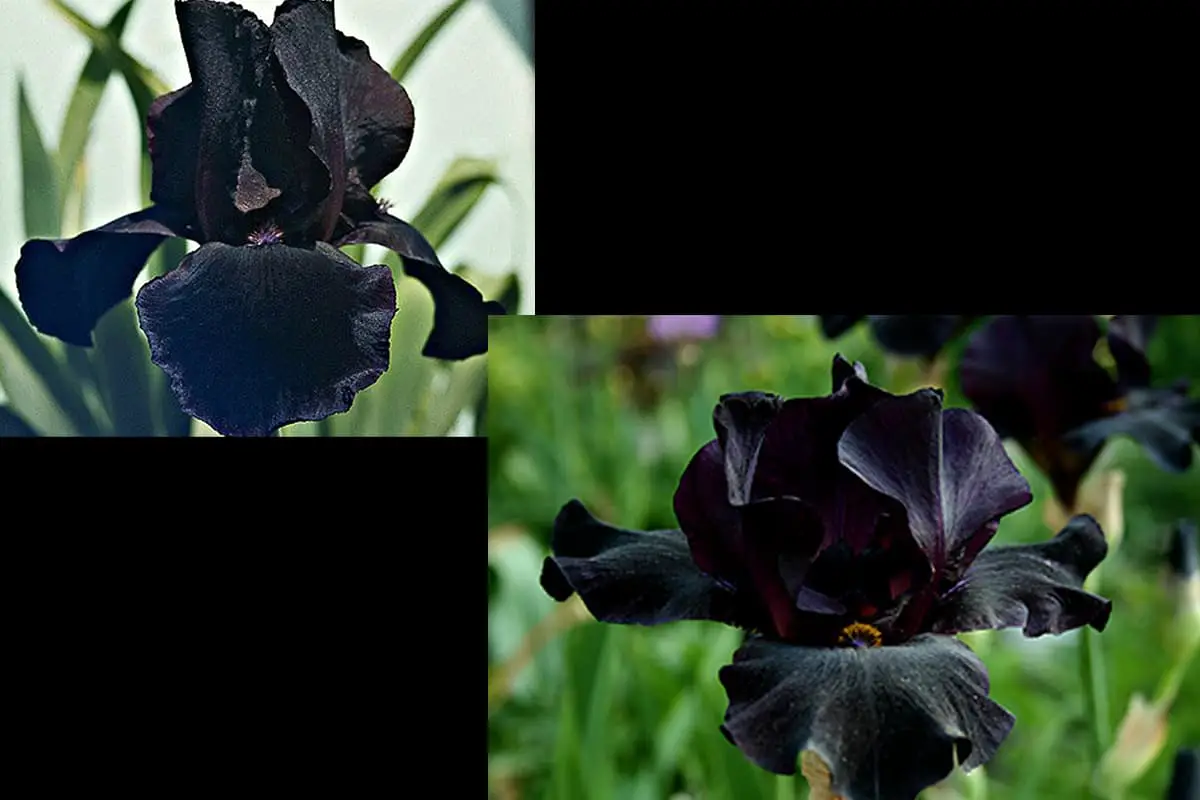
Iris nigricans, commonly known as the Black Iris, is a rare and striking perennial species native to Jordan. This herbaceous plant, belonging to the Iridaceae family, typically reaches a height of 30-40 centimeters. Its robust rhizome is characterized by a bifurcating structure, which contributes to the plant’s stability and propagation.
The foliage of Iris nigricans is distinctive, with leaves that are slightly falcate (curved like a sickle) and ensiform (sword-shaped). These leaves, measuring up to 30 cm long and 1-2 cm wide, display a yellow-green coloration and are broader in the middle, tapering at both ends. This leaf structure is an adaptation to its arid habitat, minimizing water loss while maximizing photosynthetic capacity.
The flower stems, known as scapes, are smooth and usually bear 1-2 flowers. The blooms of Iris nigricans are truly spectacular, exhibiting a deep purple color so intense that it appears almost black, hence its common name. Each flower comprises three upright petals (standards) and three drooping petals (falls). The falls are adorned with a velvety black patch speckled with darker spots, creating a mesmerizing contrast. The petals have a glossy sheen and exhibit fine, transparent veining, adding to their intricate beauty.
Iris nigricans thrives in well-drained, alkaline soils and requires full sun exposure. When cultivating this species, it’s crucial to replicate its native growing conditions. For outdoor planting, amend the soil with dolomitic limestone to achieve the desired pH level (around 7.0-8.0). The plant requires a period of cold dormancy from planting until late winter, which is essential for proper flower development.
For container cultivation, use a well-draining potting mix rich in organic matter. During the growing season (spring to early summer), ensure consistent moisture without waterlogging. After the foliage begins to yellow and wither, gradually reduce watering to induce dormancy. During this dormant period, move the container to a cool, dry location.
Fertilization should be moderate, using a balanced, slow-release fertilizer in early spring. During active growth, supplement with a diluted, phosphorus-rich liquid fertilizer every 2-3 weeks to promote robust flowering.
The ornamental value of Iris nigricans is exceptional. In its native habitat, it blooms at the end of the rainy season, typically in March or April. This timing coincides with optimal tourist seasons in Jordan, making it a significant attraction. The stark contrast of its deep purple-black flowers against the arid landscape creates a breathtaking spectacle.
It’s worth noting that Iris nigricans is the national flower of Jordan and is considered endangered in the wild due to habitat loss and over-collection. Conservation efforts are underway to protect this iconic species, and cultivation in botanical gardens plays a crucial role in its preservation.
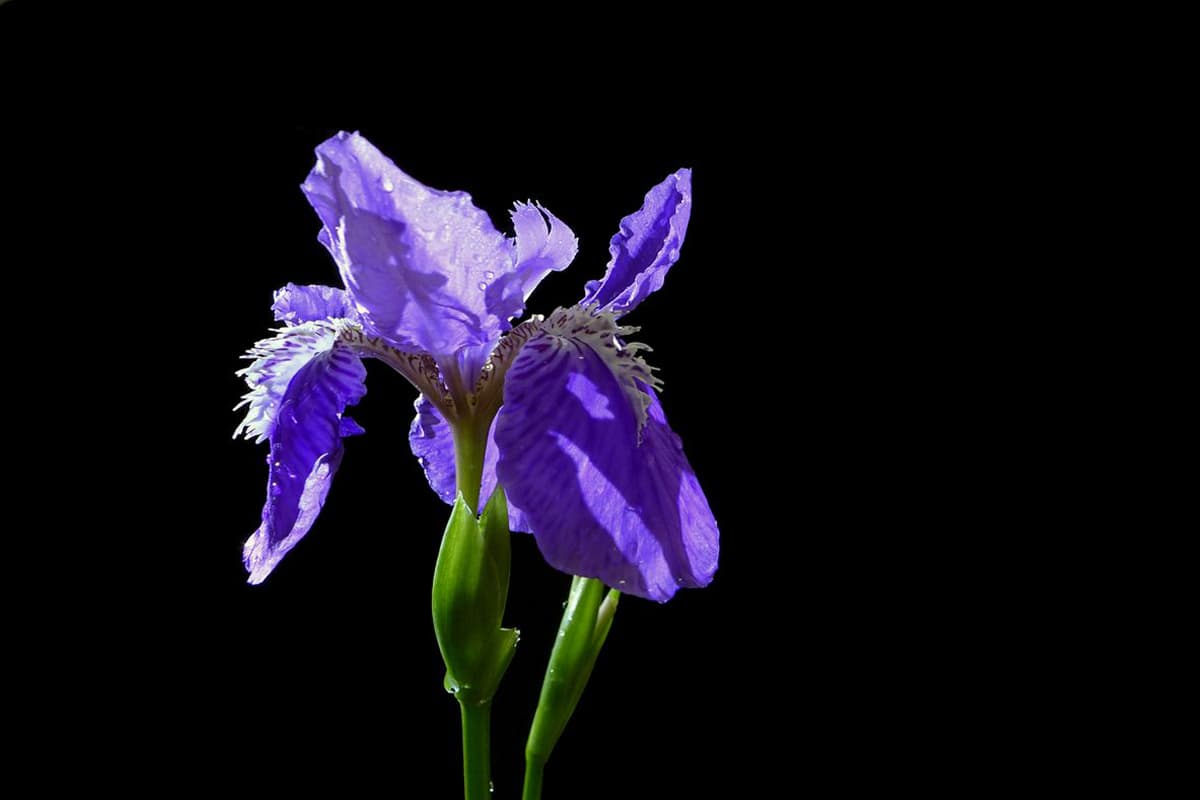
Iris tectorum, commonly known as the Japanese Roof Iris or Wall Iris, is a captivating perennial herbaceous plant belonging to the Iridaceae family. This species is distinguished by its robust rhizomatous root system and striking blue-purple flowers that bloom from April to May.
The flowers of Iris tectorum are notable for their distinctive structure. The upper part of the flower expands into a trumpet-like shape, with the falls (outer tepals) being round or broadly ovate. The standards (inner tepals) are upright and slightly smaller. Each flower typically measures 8-10 cm in diameter, creating a stunning display when in full bloom.
The foliage of Iris tectorum is equally impressive. The basal leaves are sword-shaped (ensiform) and slightly curved, exhibiting a yellow-green coloration. These leaves can reach lengths of 30-60 cm and widths of 2-4 cm, forming attractive fan-shaped clumps.
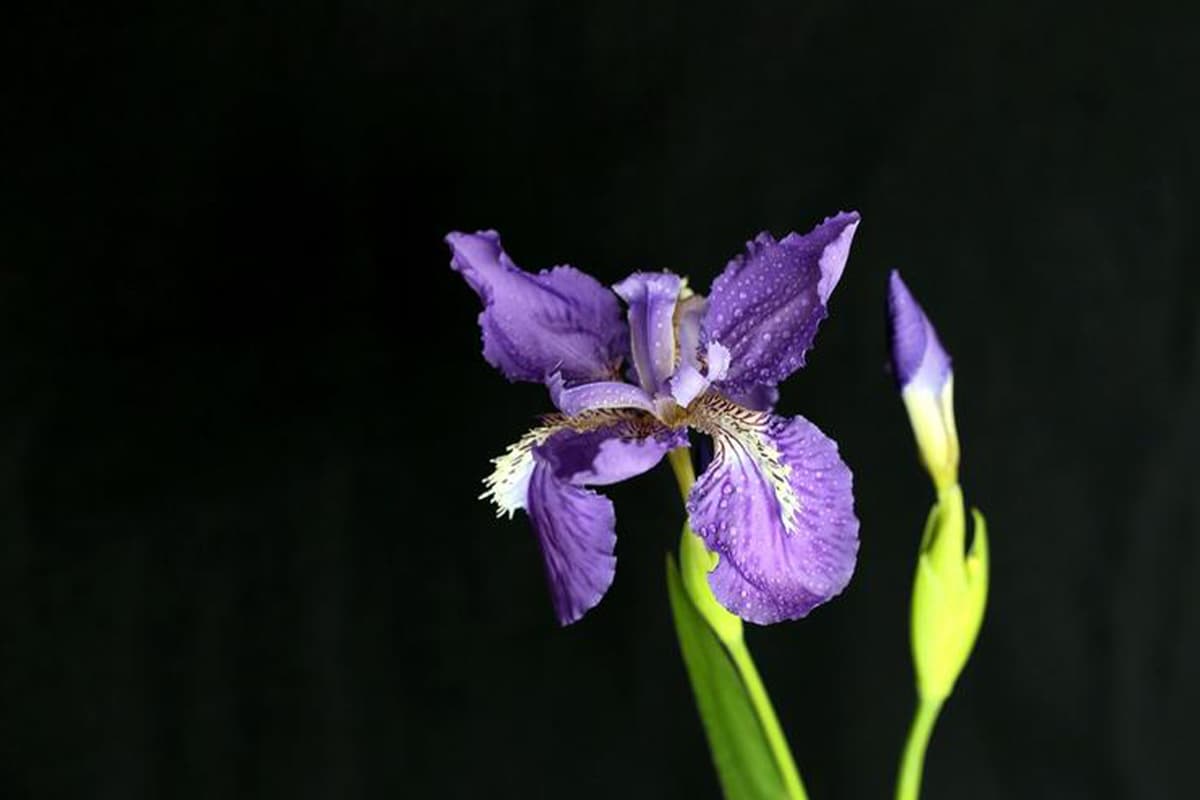
Following the flowering period, Iris tectorum produces capsule fruits from June to August. These capsules are elongated ellipsoid or obovoid in shape, typically 4-6 cm long. The seeds within are dark brown and pyriform (pear-shaped), facilitating dispersal and propagation.
Native to central China and Japan, Iris tectorum has adapted to thrive in the northern temperate zones worldwide. It prefers environments with abundant sunlight and cool climates, demonstrating remarkable cold hardiness (USDA zones 4-9). This iris performs best in well-drained, humus-rich soils with a slightly alkaline pH. While it favors moderate moisture, it can tolerate brief periods of drought once established.
Iris tectorum earned its common name “Roof Iris” due to its historical cultivation on thatched roofs in Japan, where it was believed to help hold the thatching in place. In its natural habitat, it’s often found growing on rocky slopes, near streams, or in lightly wooded areas.
Propagation of Iris tectorum is primarily achieved through rhizome division in early spring or fall. Seed propagation is also possible, though slower, with seeds requiring a period of cold stratification for optimal germination.
In traditional Chinese medicine, Iris tectorum has been utilized for its potential medicinal properties. The rhizomes, known as “She Gan,” are believed to have expectorant and anti-inflammatory effects. They have been used to treat respiratory conditions, though it’s important to note that professional medical advice should be sought before using any plant for medicinal purposes.
The striking blue-purple hue of Iris tectorum flowers has earned it the poetic moniker “Blue Enchantress” in some cultures. This coloration, combined with its subtle fragrance, makes it a prized ornamental plant in gardens and a potential source for natural dyes and perfumes.
In the language of flowers, Iris tectorum carries rich symbolism. In China, it often represents friendship and love, with its three-part flower structure symbolizing faith, wisdom, and valor. In the context of romantic love, the iris is sometimes considered a messenger of love, embodying sentiments of admiration and enduring affection.
Gardeners appreciate Iris tectorum not only for its beauty but also for its relatively low maintenance requirements and its ability to naturalize in suitable conditions. When planted in groups or drifts, it creates stunning visual displays in rock gardens, border plantings, or as a specimen plant in Asian-inspired garden designs.
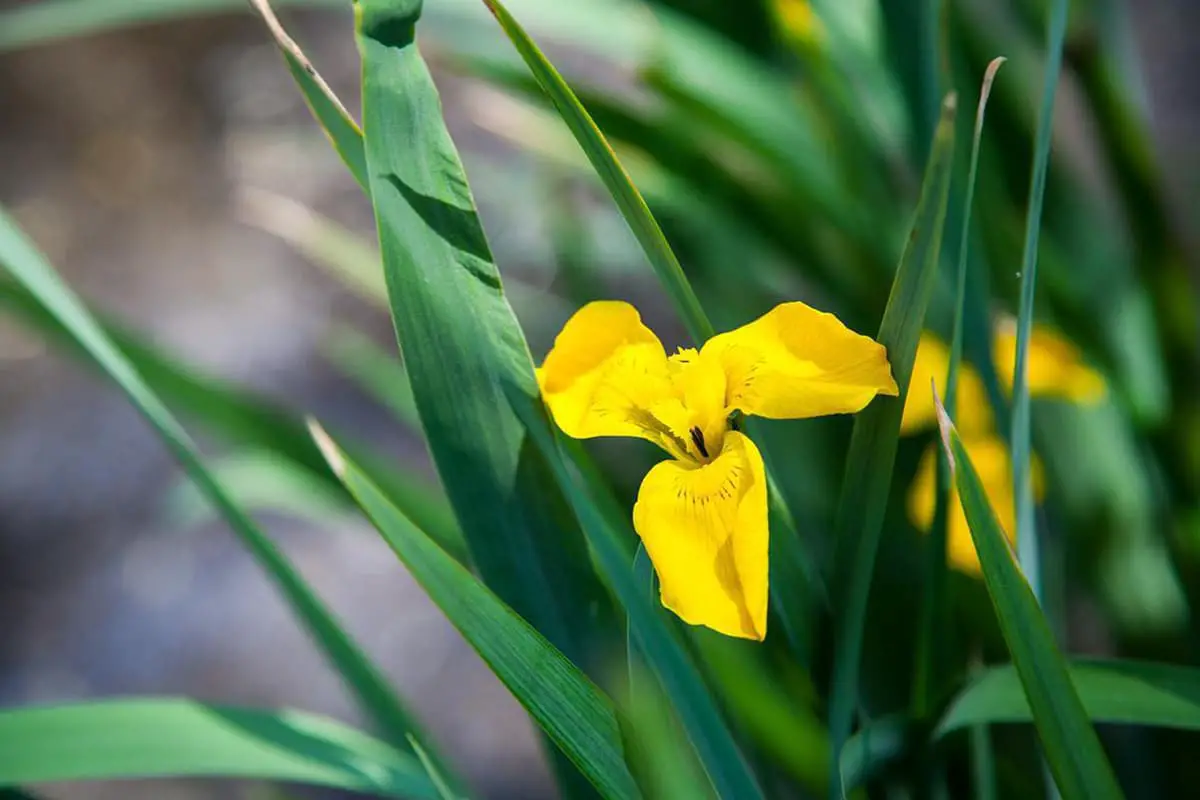
Iris wilsonii, a perennial herb, is distinguished by fibrous remnants of old leaves at its base. Its rhizome is thick and obliquely extended, sparsely branched, with yellow-white roots exhibiting characteristic shrunken transverse stripes. The basal leaves are grey-green and broadly ensiform, featuring 3-5 subtle longitudinal veins.
The flower stems are hollow, reaching 50-60 cm in height, and bear 1-2 cauline leaves. The inflorescence consists of 3 lanceolate, grass-like, green bracts, each enclosing 2 flowers. The yellow flowers measure 6-7 cm in diameter.
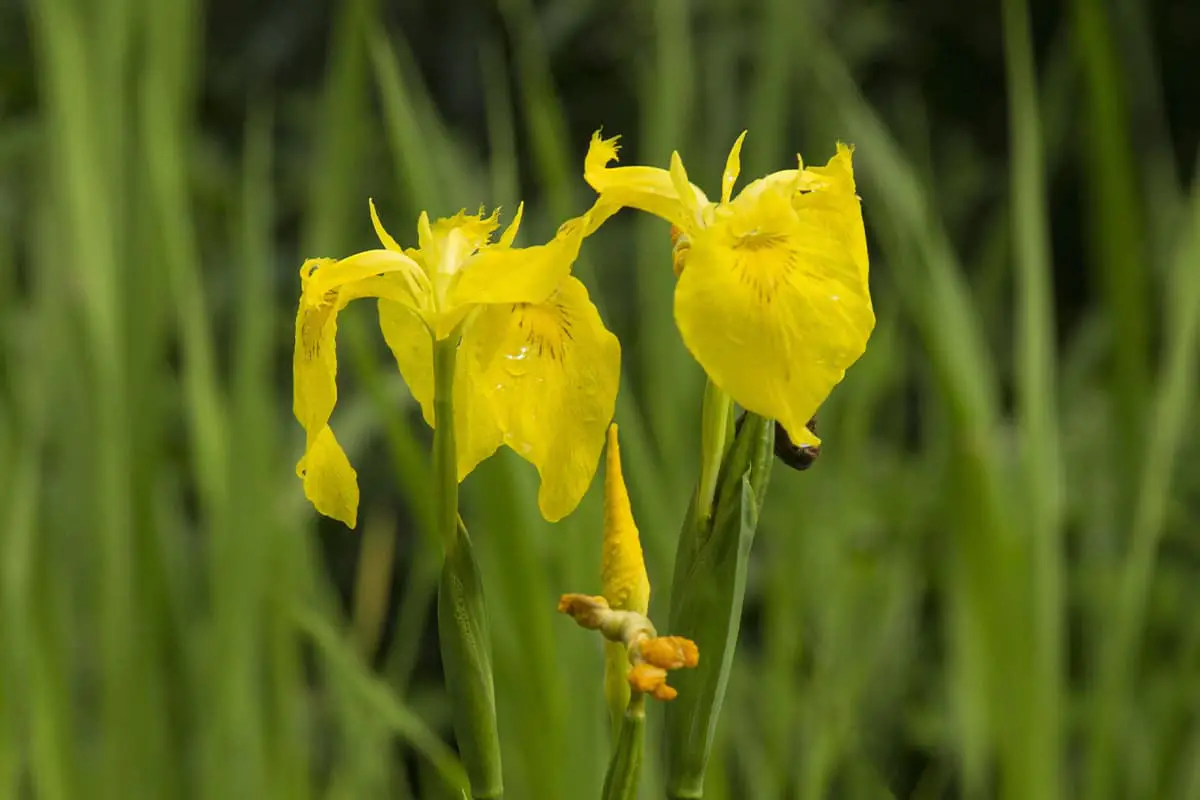
The outer perianth segments (falls) are obovate, adorned with purplish-brown striations and maculations. Their claws are narrowly cuneate. The inner perianth segments (standards) are oblanceolate and reflex outward upon anthesis.
The fruit is an elliptical-cylindrical capsule with 6 prominent ribs and lacks an apical beak. Seeds are brown, flattened, and semi-circular in shape. Flowering occurs from May to June, followed by fruiting from July to August.
Iris wilsonii thrives in diverse habitats including grassy slopes, forest-edge meadows, and riparian wetlands. Its natural distribution encompasses the Chinese provinces of Hubei, Shaanxi, Gansu, Sichuan, and Yunnan. This species holds significant horticultural value and is cultivated for ornamental purposes.
In cultivation, Iris wilsonii prefers moist, well-drained soils and partial to full sun exposure. It is relatively hardy and can tolerate USDA zones 5-9. The plant benefits from regular division every 3-4 years to maintain vigor and promote flowering. Its yellow blooms make it an excellent choice for mixed perennial borders, water gardens, or naturalized areas in the landscape.
As with many iris species, I. wilsonii may be susceptible to iris borer, leaf spot, and root rot, especially in overly wet conditions. Proper spacing and good air circulation can help mitigate these issues. Additionally, this species has potential for use in phytoremediation due to its ability to tolerate and accumulate heavy metals in contaminated soils.
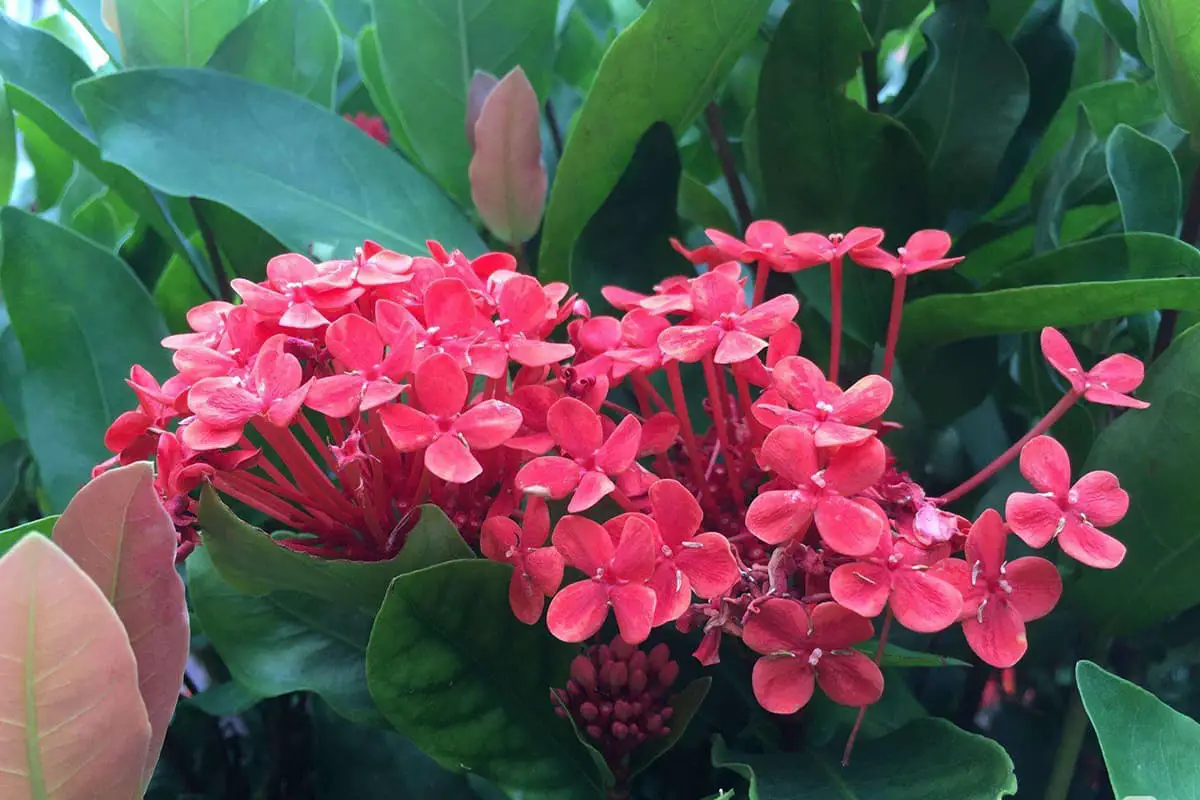
Ixora chinensis, commonly known as Chinese Ixora or flame of the woods, is a striking flowering shrub belonging to the Rubiaceae family. This compact evergreen plant is prized for its glossy foliage and vibrant, long-lasting blooms that appear in dense clusters.
Native to southern China and parts of Southeast Asia, Ixora chinensis was introduced to Europe in the late 17th century, quickly gaining popularity among horticulturists. Its natural habitat includes tropical and subtropical regions, where it thrives in warm, humid conditions.
The plant’s growth habit is characterized by a dense, rounded form, typically reaching heights of 1-2 meters (3-6 feet). Its dark green, leathery leaves are elliptical to oblong, providing an attractive backdrop for the showy flowers. The foliage remains evergreen in suitable climates, contributing to the plant’s year-round ornamental value.
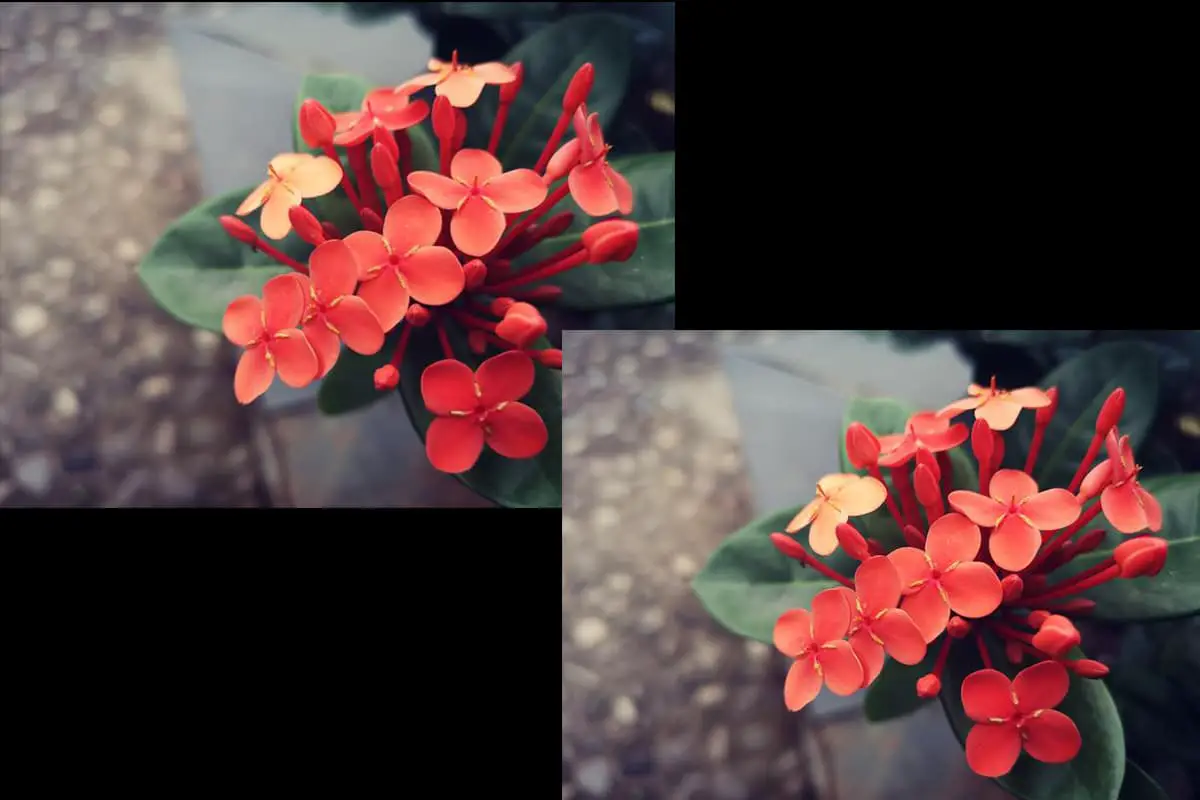
Ixora chinensis is renowned for its prolific flowering, which can occur throughout the year in tropical climates, with peak blooming from March to December. The flowers are tubular and appear in compact, rounded clusters known as corymbs. Each cluster can contain up to 60 individual flowers, creating a stunning visual display. The color palette of Ixora chinensis is diverse, including vibrant shades of red, orange, yellow, and white, as well as bi-color varieties. This wide range of colors has contributed to its popularity in landscape design and as a potted plant.
In terms of cultivation, Ixora chinensis prefers well-draining, slightly acidic soil (pH 5.5-6.5) and partial to full sun exposure. It requires regular watering but is susceptible to root rot if overwatered. In cooler climates, it can be grown as a container plant and brought indoors during winter months.
The versatility of Ixora chinensis makes it an excellent choice for various landscaping applications. In southern China and other tropical regions, it is widely used in outdoor plantings for courtyards, hotels, and scenic areas. Its compact growth habit and bright flowers make it ideal for creating colorful hedges, borders, or as a focal point in garden designs. The staggered heights and vivid blooms of mass plantings can create stunning visual effects in landscape compositions.
As a potted plant, Ixora chinensis is highly valued for both indoor and outdoor decoration. Its manageable size and year-round beauty make it suitable for patios, balconies, and indoor spaces with adequate light. The plant responds well to pruning, allowing it to be shaped into various forms for ornamental purposes.
Beyond its ornamental value, Ixora chinensis holds cultural significance in some regions. In Myanmar, it is recognized as the national flower, symbolizing the country’s natural beauty and cultural heritage. In parts of southern China, such as the Guangxi Zhuang Autonomous Region, it is colloquially referred to as “water hydrangea,” highlighting its association with lush, water-rich environments.
In conclusion, Ixora chinensis is a versatile and visually appealing plant that has earned its place as a favorite among gardeners and landscapers in tropical and subtropical regions. Its combination of attractive foliage, vibrant flowers, and adaptability to various growing conditions makes it an invaluable asset in horticultural applications, from large-scale landscape designs to intimate container gardens.